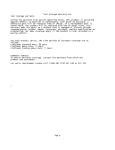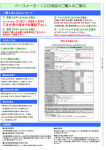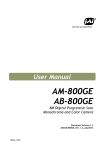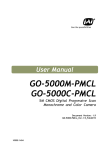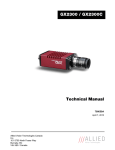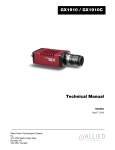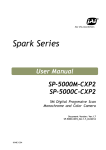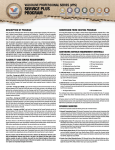Download GO-5000M-PGE GO-5000C-PGE User Manual
Transcript
User Manual GO-5000M-PGE GO-5000C-PGE 5M Digital Progressive Scan Monochrome and Color Camera Document Version: 1.2 GO-5000-PGE_Ver.1.2_May2015 1056E-1408 GO-5000M-PGE / GO-5000C-PGE Notice The material contained in this manual consists of information that is proprietary to JAI Ltd., Japan and may only be used by the purchasers of the product. JAI Ltd., Japan makes no warranty for the use of its product and assumes no responsibility for any errors which may appear or for damages resulting from the use of the information contained herein. JAI Ltd., Japan reserves the right to make changes without notice. Company and product names mentioned in this manual are trademarks or registered trademarks of their respective owners. Warranty For information about the warranty, please contact your factory representative. Certifications CE compliance As defined by the Directive 2004/108/EC of the European Parliament and of the Council, EMC (Electromagnetic compatibility), JAI Ltd., Japan declares that GO-5000M-PGE and GO-5000C-PGE comply with the following provisions applying to its standards. EN 61000-6-3 (Generic emission standard part 1) EN 61000-6-2 (Generic immunity standard part 1) FCC This equipment has been tested and found to comply with the limits for a Class B digital device, pursuant to Part 15 of the FCC Rules. These limits are designed to provide reasonable protection against harmful interference in a residential installation. This equipment generates, uses and can radiate radio frequency energy and, if not installed and used in accordance with the instructions, may cause harmful interference to radio communications. However, there is no guarantee that interference will not occur in a particular installation. If this equipment does cause harmful interference to radio or television reception, which can be determined by turning the equipment off and on, the user is encouraged to try to correct the interference by one or more of the following measures: - Reorient or relocate the receiving antenna. - Increase the separation between the equipment and receiver. - Connect the equipment into an outlet on a circuit different from that to which the receiver is connected. - Consult the dealer or an experienced radio/TV technician for help. Warning Changes or modifications to this unit not expressly approved by the party responsible for FCC compliance could void the user’s authority to operate the equipment. -2- GO-5000M-PGE Supplement The following statement is related to the regulation on “ Measures for the Administration of the control of Pollution by Electronic Information Products “ , known as “ China RoHS “. The table shows contained Hazardous Substances in this camera. mark shows that the environment-friendly use period of contained Hazardous Substances is 15 years. 嶷勣廣吭並㍻ 嗤蕎嗤墾麗嵎賜圷殆兆各式根楚燕 功象嶄鯖繁酎慌才忽佚連恢匍何〆窮徨佚連恢瞳麟半陣崙砿尖一隈〇云恢瞳ゞ 嗤蕎嗤 墾麗嵎賜圷殆兆各式根楚燕 〃泌和 桟隠聞喘豚㍉ 窮徨佚連恢瞳嶄根嗤議嗤蕎嗤墾麗嵎賜圷殆壓屎械聞喘議訳周和音氏窟伏翌 亶賜融延、窮徨佚連恢瞳喘薩聞喘乎窮徨佚連恢瞳音氏斤桟廠夛撹冢嶷麟半 賜斤児繁附、夏恢夛撹冢嶷鱒墾議豚㍉。 方忖仝15々葎豚㍉15定。 GO-5000C-PGE Supplement The following statement is related to the regulation on “ Measures for the Administration of the control of Pollution by Electronic Information Products “ , known as “ China RoHS “. The table shows contained Hazardous Substances in this camera. mark shows that the environment-friendly use period of contained Hazardous Substances is 15 years. 嶷勣廣吭並㍻ 嗤蕎嗤墾麗嵎賜圷殆兆各式根楚燕 功象嶄鯖繁酎慌才忽佚連恢匍何〆窮徨佚連恢瞳麟半陣崙砿尖一隈〇云恢瞳ゞ 嗤蕎嗤 墾麗嵎賜圷殆兆各式根楚燕 〃泌和 桟隠聞喘豚㍉ 窮徨佚連恢瞳嶄根嗤議嗤蕎嗤墾麗嵎賜圷殆壓屎械聞喘議訳周和音氏窟伏翌 亶賜融延、窮徨佚連恢瞳喘薩聞喘乎窮徨佚連恢瞳音氏斤桟廠夛撹冢嶷麟半 賜斤児繁附、夏恢夛撹冢嶷鱒墾議豚㍉。 方忖仝15々葎豚㍉15定。 GO-5000M-PGE / GO-5000C-PGE - Contents Introduction .....................................................................................- 6 Before using GigE Vision® camera...........................................................- 6 1 2 3 4 JAI GigE Vision® camera operation manuals........................................................ - 6 Software installation ................................................................................... - 6 About GigE Vision Ver2.0 .............................................................................. - 6 EMVA 1288 ................................................................................................ - 7 - Camera Operation Manual ...................................................................- 8 1. General .....................................................................................- 8 2. Camera composition ....................................................................- 8 3. Main features ............................................................................- 9 4. Locations and functions.............................................................. - 10 4.1 4.2 Locations and functions ............................................................................- 10 Rear panel ............................................................................................- 11 - 5.1 5.2 5.3 5.4 5.5 5.6 5.7 Lens used .............................................................................................- 12 Recommended PC to be used .....................................................................- 13 About the network card to be used ..............................................................- 13 JAI SDK and Control Tool software ...............................................................- 14 Cables to be used ...................................................................................- 14 DC IN / Trigger IN ...................................................................................- 14 Camera Default Settings ...........................................................................- 14 - 6.1 Connectors and pin assignment ...................................................................- 15 6.1.1 Output connector for Gigabit Ethernet ....................................................- 15 6.1.2 Hirose 6-Pin connector.......................................................................- 15 6.2 Digital IN/OUT interface ...........................................................................- 16 6.2.1 Line Selector ....................................................................................- 16 6.2.2 Line Source......................................................................................- 16 6.2.3 Line Mode .......................................................................................- 16 6.2.4 Line Inverter ....................................................................................- 16 6.2.5 Line Status ......................................................................................- 16 6.2.6 Line Format .....................................................................................- 17 6.2.7 Action Control ..................................................................................- 17 6.2.7.1 ActionDeviceKey ..........................................................................- 17 6.2.7.2 ActionSelector.............................................................................- 17 6.2.7.3 ActionGroupKey ...........................................................................- 17 6.2.7.4 ActionGroupMask .........................................................................- 17 6.2.8 GPIO ..............................................................................................- 17 6.2.8.1 Basic block diagram ......................................................................- 18 6.2.8.2 IN and OUT matrix table.................................................................- 19 6.3 Optical Interface ....................................................................................- 19 6.3.1 Recommended External Input circuit diagram for customer ...........................- 20 6.3.2 Recommended External Output circuit diagram for customer .........................- 20 6.3.3 Characteristics of optical interface.........................................................- 21 6.3.4 Opt In Filter Selector function...............................................................- 21 6.4 Pulse Generator .....................................................................................- 22 6.4.1 Clock Pre-scaler ................................................................................- 22 6.4.2 Pulse Generator Selector .....................................................................- 22 6.4.3 Pulse Generator Length .......................................................................- 23 6.4.4 Pulse Generator Start Point ..................................................................- 23 - 5. Installation and preparation .......................................................... - 12 - 6. Input and output .......................................................................... - 15 - -3- GO-5000M-PGE / GO-5000C-PGE Pulse Generator End Point ................................................................... - 23 Pulse Generator Repeat Count .............................................................. - 23 Pulse Generator Clear Activation ........................................................... - 23 Pulse Generator Clear Sync Mode........................................................... - 23 Pulse Generator Clear Source ............................................................... - 24 Pulse Generator Inverter ................................................................... - 24 Pulse Generator Setting Parameters ...................................................... - 25 - 7.1 Sensor layout ........................................................................................ - 26 7.1.1 Monochrome sensor ........................................................................... - 26 7.1.2 Bayer color sensor ........................................................................... - 26 7.2. Camera output format ............................................................................ - 27 7.2.1 1X-1Y............................................................................................. - 27 7.3 GigE Vision Pixel Format ........................................................................... - 27 7.3.1 Pixel Format .................................................................................... - 27 7.3.2 GO-5000M-PGE Pixel Type .................................................................... - 28 7.3.2.1 GVSP_PIX_MONO8 8-bit output....................................................... - 28 7.3.2.2 GVSP_PIX_MONO10 16-bit output .................................................... - 28 7.3.2.3 GVSP_PIX_MONO10PACKED 12-bit output .......................................... - 28 7.3.2.4 GVSP_PIX_MONO12 16-bit output .................................................... - 28 7.3.2.5 GVSP_PIX_MONO12PACKED 12-bit output ......................................... - 28 7.3.3 GO-5000C-PGE Pixel Type .................................................................... - 28 7.3.3.1 GVSP_PIX_BAYGR8 8-bit output ...................................................... - 28 7.3.3.2 GVSP_PIX_BAYGR10 16-bit output ................................................... - 29 7.3.3.3 GVSP_PIX_BAYGR10PACKED 12-bit output .......................................... - 29 7.3.3.4 GVSP_PIX_BAYER12 16-bit output ................................................. - 29 7.3.3.5 GVSP_PIX_BAYER12PACKED 12-bit output ......................................... - 29 7.3.4 Packet data ..................................................................................... - 30 7.4 Output timing ......................................................................................... - 30 7.4.1 Horizontal timing .............................................................................. - 30 7.4.2 Vertical timing ................................................................................. - 31 7.4.3 ROI (Region Of Interest) setting ............................................................. - 33 7.5 Digital output Bit allocation .................................................................... - 33 - 8.1. Acquisition control ................................................................................ - 34 8.1.1 Acquisition Mode............................................................................... - 34 8.1.1.1 Single Frame .............................................................................. - 34 8.1.1.2 Multi Frames .............................................................................. - 35 8.1.1.3 Continuous................................................................................. - 36 8.1.2 Acquisition Start ............................................................................... - 37 8.1.3 Acquisition Stop ................................................................................ - 37 8.1.4 Acquisition frame rate ........................................................................ - 37 8.1.5 Calculation of the maximum frame rate .................................................. - 38 8.2. Exposure settings .................................................................................. - 39 8.2.1 Exposure Mode ................................................................................. - 39 8.2.2 Exposure Time.................................................................................. - 40 8.2.3 Exposure Auto .................................................................................. - 40 8.3. Trigger Control ..................................................................................... - 41 8.3.1 Trigger Selector ................................................................................ - 41 8.3.2 Trigger Mode .................................................................................... - 42 8.3.3 Trigger Source .................................................................................. - 42 8.3.4 Trigger activation .............................................................................. - 42 8.3.5 Trigger Overlap................................................................................. - 43 - 7. 8. 6.4.5 6.4.6 6.4.7 6.4.8 6.4.9 6.4.10 6.4.11 Sensor layout, output format and timing ......................................... - 26 - Operating modes ...................................................................... - 34 - -4- GO-5000M-PGE / GO-5000C-PGE 8.4. Normal continuous operation (Timed Exposure Mode/Trigger Mode OFF) ................- 43 8.5. Timed mode .........................................................................................- 43 8.6. Trigger width mode ................................................................................- 44 8.7. RCT (Reset Continuous Trigger) mode ..........................................................- 45 8.8 Video Send Mode ....................................................................................- 46 8.8.1 Sequence Mode .................................................................................- 46 8.8.1.1 Trigger Sequence mode basic timing ..................................................- 47 8.8.1.2 Sequence index table (Default) ........................................................- 48 8.8.1.3 Descriptions of index table parameters ..............................................- 48 8.9 Multi ROI mode ......................................................................................- 49 8.9.1 Multi ROI setting parameters ................................................................- 49 8.10 Delayed Readout function ........................................................................- 50 - 9.1 Black level control ..................................................................................- 52 9.1.1 Black Level Selector ...........................................................................- 52 9.1.2 Black Level ......................................................................................- 52 9.2 Gain control ..........................................................................................- 52 9.2.1 Gain Selector ...................................................................................- 53 9.2.2 Gain ..............................................................................................- 53 9.2.3 Gain RAW ........................................................................................- 53 9.2.4 Gain Auto ........................................................................................- 54 9.2.5 Balance White Auto ............................................................................- 54 9.3. LUT ...................................................................................................- 55 9.3.1 LUT Enable ......................................................................................- 55 9.3.2 LUT Index ........................................................................................- 55 9.3.3 LUT value ........................................................................................- 55 9.4. Gamma ...............................................................................................- 55 9.4.1 Linear and Dark Compression ................................................................- 56 9.5. Blemish compensation.............................................................................- 56 9.6 ALC ....................................................................................................- 57 9.7 HDR (High Dynamic Range)(GO-5000M-PGE only)..............................................- 58 - 9. Other functions ........................................................................ - 52 - 10. Camera setting ....................................................................... - 59 - 10.1 11. 12. 12.1 12.2 Camera Control Tool ..............................................................................- 59 - External appearance and dimensions .......................................... - 60 Specifications......................................................................... - 61 - Spectral response ..................................................................................- 61 Specifications table ...............................................................................- 62 - Appendix ...................................................................................... - 65 1. 2. 3. 4. 5. 6. Precautions..............................................................................................- 65 Typical Sensor Characteristics .......................................................................- 65 Caution when mounting a lens on the camera ....................................................- 65 Caution when mounting the camera ................................................................- 66 Exportation..............................................................................................- 66 References ..............................................................................................- 66 - Manual change history ...................................................................... - 67 User's Record ................................................................................. - 68 - -5- GO-5000M-PGE / GO-5000C-PGE Introduction Before using GigE Vision® camera All software products described in this manual pertain to the proper use of JAI GigE Vision® cameras. Product names mentioned in this manual are used only for the explanation of operation. Registered trademarks or trademarks belong to their manufacturers. To use the JAI SDK, it is necessary to accept the “Software license agreement” first. This manual describes necessary equipment and the details of camera functions. 1 JAI GigE Vision® camera operation manuals To understand and operate this JAI GigE Vision camera properly, JAI provides the following manuals. User’s manual (this booklet) Describes functions and operation of the hardware JAI SDK & Control Tool User Guide Describes functions and operation of the Control Tool JAI SDK Getting Started Guide Describes the network interface User’s manual is available at www.jai.com 2 Software installation The JAI GigE Vision SDK & Control Tool can be downloaded from the JAI web site at www.jai.com. The JAI SDK is available for Windows XP, Vista, and Windows 7, 32-bit and 64-bit. For the details of software installation, please refer to the “Getting Started Guide” supplied on the JAI SDK download page. 3 About GigE Vision Ver2.0 The GO-5000-PGE complies with the latest GigE Vision version 2.0. GigE Vision is the new standard interface using Gigabit Ethernet for machine vision applications and it was mainly set up by AIA (Automated Imaging Association) members. GigE Vision is capable of transmitting large amounts of uncompressed image data through an inexpensive general purpose LAN cable for a long distance. GigE Vision also supports the GenICamTM standard which is mainly set up by the EMVA (European Machine Vision Association). The purpose of the GenICam standard is to provide a common program interface for various machine vision cameras. By using GenICam, cameras from different manufactures can seamlessly connect in one platform. For details about the GigE Vision standard, please visit the AIA web site, www.machinevisiononline.org and for GenICam, the EMVA web site, www.genicam.org. -6- GO-5000M-PGE / GO-5000C-PGE 4 EMVA 1288 With regard to signal to noise ratio in this manual, specifications measured by EMVA 1288 are used together with specifications by a traditional measurement method. EMVA 1288 is a more complete measurement that considers multiple noise sources, including random noise, pattern noise, and shading. Additionally, EMVA 1288 incorporates temporal variances in pixel output by capturing 100 frames of data and computing the RMS variations over the captured frames. Because of the comprehensive nature of the noise analysis and the additional consideration for RMS variances over time, EMVA 1288 SNR measurements are inherently lower than the traditional SNR measurements given by manufacturers. However, the comprehensive nature combined with rigid test parameters, means that all manufacturers are measuring their products equally and EMVA 1288 tested parameters can be compared among different manufacturers’ products. In order to learn more about EMVA 1288, please visit http://www.emva.org -7- GO-5000M-PGE / GO-5000C-PGE Camera Operation Manual 1. General The GO-5000M-PGE and GO-5000C-PGE are members of JAI’s Go Series, offering users small yet rugged cameras equipped with fundamental functions for machine vision. They are high performance cameras with high resolution and a frame rate suitable for a range of applications. The GO-5000M-PGE is a monochrome progressive scan CMOS camera and the GO-5000C-PGE is the equivalent Bayer mosaic progressive scan CMOS camera. Both are equipped with a CMOS sensor offering a 1-inch optical format, a resolution of 5.24 million pixels, and a 5:4 aspect ratio. They provide up to 22.3 frames per second for continuous scanning with 2560 x 2048 full pixel resolution for both monochrome and raw Bayer 8-bit outputs. 8-bit, 10-bit or 12-bit output can be selected for both monochrome and raw Bayer formats. The new cameras feature a GigE Vision Ver. 2.0 interface and also a Power Over Ethernet function. The GO-5000M-PGE and GO-5000C-PGE have various comprehensive functions needed for automated optical inspection applications, such as solid state device inspection or material surface inspection. They incorporate video processing functions such as a look-up table, shading compensation and blemish compensation in addition to fundamental functions such as trigger, exposure setting, and video level control. The latest version of this manual can be downloaded from: www.jai.com The latest version of the Camera Control Tool for the GO-5000M-PGE and GO-5000C-PGE can be downloaded from: www.jai.com For camera revision history, please contact your local JAI distributor. 2. Camera composition The standard camera composition is as follows. Camera body 1 Sensor protection cap 1 Dear Customer (sheet) 1 The following optional accessories are available. Tripod base Power supply unit MP-43 PD-12 series -8- GO-5000M-PGE / GO-5000C-PGE 3. Main features New Compact and Rugged housing Series, 1” progressive scan camera Intelligent body design for easy and flexible installation Utilizes new GigE Vision ver.2.0 and IEEE802.3af PoE Aspect ratio 5:4, 2560(H) x 2048(V) - 5.2 million effective pixels 5 μm square pixels S/N 55 dB for monochrome and 50 dB for color with Dark Compression ON 8-bit, 10-bit or 12-bit output for monochrome and Bayer 22.3 frames/second with full resolution in continuous operation (8-bit) Various readout modes, including horizontal and vertical binning (GO-5000M-PGE only), and ROI (Region Of Interest) for faster frame rates 0 dB to +24 dB gain control for both GO-5000M-PGE and GO-5000C-PGE 10 μs (1/100,000) to 8 seconds exposure control in 1 μs step Auto exposure control Timed and trigger width exposure control RCT trigger mode for specific applications ALC control with combined function of AGC and auto exposure HDR (High Dynamic Range) function is available (GO-5000M-PGE only) Various pre-processing circuits are provided Programmable LUT Gamma correction (0.45, 0.6 and 1.0 3 steps) Bayer white balance with manual or continuous auto (GO-5000C-PGE only) Blemish compensation C-mount for lens mount Setup by Windows XP/Vista/7/8 via serial communication -9- GO-5000M-PGE / GO-5000C-PGE 4. Locations and functions 4.1 Locations and functions Lens mount RJ45 connector LED 6-pin connector LED (ACT) LED (LINK) Mounting holes C-mount (Note *1) Gigabit Ethernet connection Indicator for power and trigger input DC and trigger input GigE network indication (ACT) GigE network indication (LINK) Holes for mounting tripod base or direct installation. Depth 3 mm (Note*3) Note1: Rear protrusion on C-mount lens must be less than 10.0 mm. Note2: When an RJ-45 cable with thumbscrews is connected to the camera, please do not Excessively tighten screws by using a screw driver. The RJ-45 receptacle on the camera might be damaged. For security, the strength to tighten screws is less than 0.147 Newton meter (Nm). Tightening by hand is sufficient in order to achieve this. Note3: The part number for the tripod adapter plate (with 1/4"-20 thread) is MP-43 (option). Fig. 1 Locations - 10 - GO-5000M-PGE / GO-5000C-PGE 4.2 Rear panel The rear panel mounted LEDs provide the following information: POWER/TRIG Amber: Power connected – initiating This light goes OFF after initiating. Steady green: Camera is operating in Continuous mode Flashing green: The camera is receiving external triggering Note: The interval of flashing does not correspond with external trigger duration. ② ③ ① Fig. 2 LINK Steady green: Connecting in 1000BASE-T Flashing green: Connecting in 100BASE-T ACT Flashing amber: GigE Network indication - 11 - Rear panel GO-5000M-PGE / GO-5000C-PGE 5. Installation and preparation Before starting operation, check to make sure that all equipment is appropriate and is connected in the right manner. ④ JAI SDK Connecting to PC ② PC ③ NIC ① Lens 1-inch, C mount ➄ LAN Cable External Trigger Hirose 6P ➅ DC IN / Trigegr IN 5.1 Lens used Fig3 Basic system The GO-5000-PGE employs a 1-inch CMOS imager. It is necessary to select a 1-inch C mount lens if the full resolution of the camera is to be utilized. The imager used in the GO-5000-PGE measures 16.392 mm diagonally, which is slightly larger than the standard 16 mm diagonal of the 1-inch format. Please consult with your lens provider to select a 1-inch lens able to cover 16.392 mm diagonally, otherwise the image captured may show vignetting. It is possible to use C mount lenses with an optical format smaller than 1-inch, provided a less-than full-resolution ROI is going to be used. For example, a centered ROI of 1920 x 1080 pixels (HD format) will fit inside the image circle of most standard 2/3-inch C mount lenses. Likewise, a centered VGA ROI (640 x 480 pixels) can be accommodated by a standard 1/3-inch C mount lens. The rear protrusion on any lens used must be less than 10 mm. The focal length of lens used is estimated by the following formula. Focal length = 𝑊𝐷/(1 + 𝑊/𝑤) Here, WD: Working distance (the distance between lens and object) W: Width of object w: Width of sensor (the GO-5000-PGE is 12.8 mm) - 12 - GO-5000M-PGE / GO-5000C-PGE 5.2 Recommended PC to be used The PC used should have the following performance or better 1) Recommended CPU : Core i3 or better, 2) Recommended memory: DDR3, 4GB fully equipped (Windows 7 32-bit) DDR3, 8GB fully equipped (Windows 7 64-bit) 3) Graphics card : Should apply with PCI Express Generation 3.0 or better 4) NIC : Use Intel NIC PCI-Express Bus to install Intel NIC should be better than Generation 2.0. Generation 1.0 cannot be used. 5) Other: If the picture is always displayed on the monitor, it is not recommended to use the CPU in the PC. 5.3 About the network card to be used The network card should comply with 1000BASE-T and also have the capability of JUMBO FRAMES. When the jumbo frame size is set at a larger number, the load on the CPU will be decreased. Additionally, as the overhead of the packet is decreased, the transmission will have more redundancy. Table-1 JAI confirms the following network cards. NIC PCI-X Bus Manufacture Type Intel PRO/1000MT Server Adapter Intel PRO/1000MT Dual Port Server Adapter Intel PRO/1000GT Quad Port Server Adapter Intel PRO/1000PT ― Server Adapter Intel Pro/1000 CT ― Desktop adaptor Intel Gigabit ET2 Quad port ― Server Adapter Intel Gigabit ET Dual port ― Server Adapter Intel Gigabit EF Dual port ― Server Adapter PCI-Express Bus ( x1 ) ( x1 ) ( x4 ) ( x4 ) ( x4 ) 32bit or 64bit 33/66/100/133 MHz 32bit or 64bit 33/66/100/133 MHz 32bit or 64bit 66/100/133 MHz 2.5Gbps uni-directional 5Gbps bi-directional 2.5Gbps uni-directional 5Gbps bi-directional 10Gbps uni-directional 20Gbps bi-directional 10Gbps uni-directional 20Gbps bi-directional 10Gbps uni-directional 20Gbps bi-directional Notes for connecting 100BASE-TX In order to use 100 Mbps network, 100BASE-TX and Full Duplex are available. Half Duplex cannot be used. In the case of connecting on 100BASE-TX, the maximum packet size should be 1500 bytes. In the case of connecting on 100BASE-TX, the specifications such as frame rate, trigger interval and so on described in this manual cannot be satisfied. - 13 - GO-5000M-PGE / GO-5000C-PGE 5.4 JAI SDK and Control Tool software The GO-5000M-PGE and GO-5000C-PGE are designed to use the JAI SDK and Control Tool software to control camera functions. All controllable functions are stored in the camera’s XML file. The JAI SDK can be downloaded from www.jai.com. Third-party software can also be used with the camera provided it is compliant with the GenICam® standard. 5.5 Cables to be used GigEVision configures the system by using 1000BASE-T. In the market, CAT5e (125MHz), CAT6 (250MHz) and CAT7 (600MHz) cables are available for 1000BASE-T. There are crossover cables and straight through cables available. Currently, as most equipment complies with Auto MDI/MDI-X, please use straight through cables. (Among crossover cables, a half crossover type exists, which the Ethernet will recognize as 100BASE-T). The GO-5000-PGE also has PoE (Power Over Ethernet) capability and DC power is supplied through LAN cable. 5.6 DC IN / Trigger IN The GO-5000-PGE supports a PoE (Power over Ethernet) function which complies with IEEE 802.3af. Therefore, the Gigabit Ethernet interface card used in the PC needs to have this capability too. However, if the Gigabit Ethernet network card does not have this capability, GO-5000-PGE provides a 6P connector to receive +12 to +24V DC to operate the camera. The 6P connector is also used to provide external trigger input. 5.7 Camera Default Settings When the camera is connected to a PC and JAI SDK 2.0 is started up, an XML file which stores default settings of the camera is downloaded to the JAI_SDK camera control tool. The default settings of the GO-5000-PGE are as follows. Table – 2 Default settings Image Format Trigger Operation Exposure Control Gain Bit allocation Height Binning Horizontal (Note) Binning Vertical (Note) Trigger Mode Exposure Mode Gain Auto Manual Gain all Manual Fine Gain all Analogue Base Gain Note: GO-5000M-PGE only. - 14 - 8-bit 2048 OFF OFF OFF OFF OFF 0 0 0dB GO-5000M-PGE / GO-5000C-PGE 6. Input and output 6.1 Connectors and pin assignment 6.1.1 Output connector for Gigabit Ethernet Type: RJ-45 8 7 6 5 4 3 2 1 Fig.4 RJ-45 connector (View from outside) The digital output signals follow the Gigabit Ethernet interface using an RJ-45 conforming connector. The following table shows pin configuration. Table-3 RJ-45 pin configuration Pin No. Input /Output 1 In/Out 2 In/Out 3 In/Out 4 In/Out 5 In/Out 6 In/Out 7 In/Out 8 In/Out Description MX1+ (DA+) MX1- (DA-) MX2+ (DB+) MX3+ (DC+) MX3- (DC-) MX2- (DB-) MX4+ (DD+) MX4- (DD-) 6.1.2 Hirose 6-Pin connector Type: HR-10A-7R-6PB(73) Hirose or equivalent 1 6 2 5 3 4 Fig.5 6-pin connector (view from outside) Table-4 Hirose 6P pin assignment Pin no. I/O Signal 1 DC in 2 I Opto in1 3 O Opto out1 4 O Opto out2 5 Opto Common 6 GND Remarks +12V ~ +24V GPIO 5 GPIO 1 GPIO 2 - 15 - GO-5000M-PGE / GO-5000C-PGE 6.2 Digital IN/OUT interface In the GO-5000M-PGE and GO-5000C-PGE, the digital IN/OUT capability in the software control tool can assign the necessary signals needed for the system. 6.2.1 Line Selector In the Line Selector, the following input and output signals can be assigned. Table-5 Line selector Line Selector item Description Line 1 Opt 1 Out Opt 1 output from # 3 of DC In/Trigger 6-Pin on the rear Line 2 Opt 2 Out Opt 2 output from #4 of DC In/Trigger 6-Pin on the rear NAND 0 In 1 No. 1 input to NAND 0 gate in GPIO NAND 0 In 2 No. 2 input to NAND 0 gate in GPIO NAND 1 In 1 No. 1 input to NAND 1 gate in GPIO NAND 1 in 2 No. 2 input to NAND 1 gate in GPIO Note1: Select and connect the line source signal against the item selected in the line selector. 6.2.2 Line Source Line source signal can be selected from the following table to connect it to the line item which is selected in the line selector. Table-6 Line Source Line Source item Description Low High Acquisition Trigger Wait Frame Trigger Wait Frame Active Exposure Active FVAL PulseGenerator0 Out User Out 0 User Out 1 Line 5 Opt In NAND 0 Out NAND 1 Out Connect Low Level signal to line item selected in Line Selector, Default setting Connect High Level signal to line item selected in Line Selector Connect Acquisition Trigger Wait signal to line item selected in Line Selector Connect Frame Trigger Wait signal to line item selected in Line Selector Connect Frame Active signal to line item selected in Line Selector Connect Exposure Active signal to line item selected in Line Selector Connect FVAL signal to line item selected in Line Selector Connect Pulse Generator 0 signal to line item selected in Line Selector Connect User Out 0 signal to line item selected in Line Selector Connect User Out 1 signal to line item selected in Line Selector Connect Opt In signal to line 6 in Line Selector Connect NAND 0 signal to line item selected in Line Selector Connect NAND 1 signal to line item selected in Line Selector 6.2.3 Line Mode Indicates the status of the interface. (Input, Output or Internal) 6.2.4 Line Inverter Sets the polarity of the selected input or output. (False or True) 6.2.5 Line Status Indicates the status of the selected signal, input or output (True=High or False=Low) - 16 - GO-5000M-PGE / GO-5000C-PGE 6.2.6 Line Format Indicates the format of the line item selected in Line Selector. (No Connect, TTL, LVDS, Opt Coupled or Internal Signal) Note: In the GO-5000-PGE, TTL and LVDS interface are not equipped. 6.2.7 Action Control Action control settings allow the use of unicast or broadcast Action Commands as defined in the GigE Vision 2.0 specification. ACTION_CMD messages received via the GVCP port can control the camera’s internal action signals provided the camera’s action control settings match the settings of the message received. This function is useful for triggering an action in multiple cameras at roughly the same time. There are two action control inputs on the GO-5000-PGE and they are connected to four triggers, counter reset, counter, and timer. When action control is used, the trigger input source should be set to Action 1 or Action 2 in advance. 6.2.7.1 ActionDeviceKey Sets the device key value for the camera in a 32-bit register. This value must match the device_key value of the ACTION_CMD message in order for the message to be acted upon. . 6.2.7.2 ActionSelector Selects Action 1 or Action 2 for setting the action control values. 6.2.7.3 ActionGroupKey Sets the group key value for the selected action signal in a 32-bit register. This value must match the group_key value of the ACTION_CMD message in order for the message to be acted upon. 6.2.7.4 ActionGroupMask Sets the mask value for the selected action signal in a 32-bit register. This value is compared against the group mask value of the ACTION_CMD message to determine if the message should be ignored or acted upon. A logical AND operation is used and must produce a non-zero result or else the message is ignored.. 6.2.8 GPIO This is a general interface for input and output and controls input and output for trigger signals or valid signals and pulse generator. By using this interface, you can control an external light source, make a delayed function to input a trigger signal or make a precise exposure control with PWC trigger. - 17 - GO-5000M-PGE / GO-5000C-PGE 6.2.8.1 Basic block diagram Sel Bit (5,0) Sel Bit (7) Soft Trigger LVAL IN InvEn FVAL IN Exposure Active Frame Trigger Wait Frame Active Sel Bit (7) User out 0 InvEn User out 1 Action 1 Action 2 Trigger 0 (Acquisition Start) Trigger 1 (Acquisition Stop) Trigger 2 (Frame Start) Trigger 3 (Transfer Start) GPIO 1 (OPT OUT 1) GPIO 2 (OPT OUT 2) Time Stamp Reset InvEN Cross Point Switch NAND 1 NAND 2 NAND Sel Bit (7) InvEN GPIO 5 (OPT IN) Pulse Generator 0 Pixel Clock 12 bit Counter Fig. 6 GPIO - 18 - Pulse Generator 20 bit counter x 1 CLR GO-5000M-PGE / GO-5000C-PGE 6.2.8.2 IN and OUT matrix table The following table shows the input and output matrix table. Table-7 GPIO IN and OUT matrix table Pulse Selector (Cross Trigger Selector point switch output) Pulse Generator 0 NAND 2 In 2 NAND 2 In 1 NAND 1 In 2 NAND 1 In 1 GPIO 2 - 12P Opt Out 2 GPIO 1 - 12P OPT Out 1 Transfer Start Frame Start Acquisition Stop Trigger Source 6.3 Generator Selector Acquisition Start Source signal (Cross point switch input) LOW HIGH GPIO 5 - 6P OPT 1 In NAND 1 Out 1 NAND 2 Out 1 Pulse Generator 0 User Output 0 User Output 1 Software Trigger Action 1 Action 2 FVAL LVAL Exposure Active Frame Trigger Wait Frame Active Line Selector Line Source Pulse Generator Clear Source Optical Interface The GO-5000-PGE is equipped with opto-isolated inputs and outputs, providing galvanic separation between the camera’s inputs/outputs and peripheral equipment. In addition to galvanic separation, the opto-isolated inputs and outputs can cope with a wide range of voltages; the voltage range for inputs is +3.3V to +24V DC whereas outputs will handle +5V to +24V DC. The following drawing is the concept of photo coupler Fig.7 Photo coupler - 19 - GO-5000M-PGE / GO-5000C-PGE 6.3.1 Recommended External Input circuit diagram for customer User side JAI GO Series CAMERA side BF545C 180CS S D G USER POWER1 +3.3V to +24V +3.3V TLP2366 1 6 1SS400 HIROSE_6Pin_No.1 5 3 HIROSE_6Pin_No.5 IN 4 Fig.8 Example of external input circuit 6.3.2 Recommended External Output circuit diagram for customer Standard circuit Userload User (resistor/lamp/relay/etc) side JAI GO Series CAMERA side OUT f rom camera 330~ 330 OUT TLP109(TPR,E) HIROSE_6Pin_NO.3 or 4 2SC6033 6 1 180BS 5 220BS 4k7 4k7 HIROSE_6Pin_No.5 4 3 1SS400 USER POWER2 +5V to +24V 100KBS 220BS 2SC6033 Fig.9 Example of external output circuit(Standard) Simple circuit Userload User (resistor/lamp/relay/etc) side JAI GO Series CAMERA side OUT f rom camera 330 OUT TLP109(TPR,E) HIROSE_6Pin_NO.3 or 4 6 1 180BS 5 220BS +5V to +24V 4 1SS400 USER POWER3 3 100KBS HIROSE_6Pin_No.5 220BS 2SC6033 Fig.10 330Ω Ω Example of external output circuit(Simple) - 20 - GO-5000M-PGE / GO-5000C-PGE 6.3.3 Characteristics of optical interface The relationship of the input signal to the output signal through the optical interface is as follows. Input Line Voltage Range : Input Current : Output Load(Maximum Current) : Minimum Input Pulse Width to Turn ON : Minimum Output Pulse Width : +3.3v~+24V 6mA~30mA 100mA 0.5us 20us Table-8 Optical interface Characteristic on User Output circuit R1, R4 (in Fig.9)= 330ΩPULL_UP User Power (Vcc) 3.3v 5.0v 12v 24v Time Delay Rise TDR(us) 0.78 0.82 1.8 2.65 Rise Time 4.1 4.7 6.1 9.1 Time Delay Fall TDF(us) 0.26 0.48 0.56 0.78 Fall Time 1.3 1.6 3.1 4.8 RT(us) FT(us) Fig.11 6.3.4 Optical interface characteristics Opt In Filter Selector function As for the surge protection of the optical input, the filter can be selected from 5 steps which are 10 µs (Typical), 100 µs, 500 µs, 1 ms and 10 ms. If the filter is set, a pulse with a shorter width than the filter setting value cannot be accepted. - 21 - GO-5000M-PGE / GO-5000C-PGE 6.4 Pulse Generator The GO-5000-PGE has a frequency divider using the pixel clock as the basic clock and a pulse generator. In the Pulse Generator, various Clear settings are connected to GPIO. The following shows the Pulse Generator default settings. Table-9 Pulse Generator default settings Display Name Clock Pre-scaler Value 1 Pulse Generator Length Start Point End Repeat Clear Clear Clear Clear Pulse Generator Point Count Source Inverter Activation Sync Selector Mode 1 0 1 0 Off True Off Async Mode - Pulse Generator 0 Note: When Pulse Generator Repeat Count is set to “0”, the camera is operating in free-running mode. However, based on the above default setting, Length=1, Start Point=0 and End Point=1, Pulse Generator stops at High output. Therefore, if Start Point=0 and End Point=1 are configured, Length should be “2” as the minimum active width. 6.4.1 Clock Pre-scaler Clock pre-scaler (Divide Value) can set the dividing value of the frequency divider (12-bit length) and the pixel clock is used for this. In the GO-5000-PGE, the pixel clock is set at 48 MHz. 6.4.2 Pulse Generator Selector This is where you select a pulse generator. In the GO-5000-PGE, it is fixed to Pulse Generator 0. Table-10 Pulse Generator setting Trigger Selector Description item Pulse Generator 0 If Pulse Generator 0 is selected, Length Start Point, End Point, Repeat Count, Clear Source, Clear Inverter Clear Activation and Clear Sync Mode of pulse generator 0 are displayed under the selector. Pulse generator Clear source IN (Clear activation = Rising edge Clear SYNC mode = Async) Pulse generator repeat count = N (Pulse generator length x N) Pulse generator length Pulse generator length Pulse generator length Pulse generator Output 0 0 0 Pulse generator End point Pulse generator Start point Fig.12 Pulse Generator pulse construction - 22 - GO-5000M-PGE / GO-5000C-PGE 6.4.3 Pulse Generator Length Set the counter up value (number of clocks, refer to Table 11) for the pulse generator. If Repeat Count value is “0”, and if Pulse Generator Clear signal is not input, the pulse generator generates the pulse repeatedly until reaching this counter up value. 6.4.4 Pulse Generator Start Point Set the active output start count value for the pulse generator. However, please note that a maximum 1 clock jitter for the clock which is divided in the clock pre-scaler can occur. 6.4.5 Pulse Generator End Point Set the active output ending count value for the pulse generator. 6.4.6 Pulse Generator Repeat Count Set the repeating number of the pulse for the pulse generator. After Trigger Clear signal is input, the pulse generator starts the count set in Repeat Count. Accordingly, an active pulse which has a start point and end point can be output repeatedly. However, if Repeat Count is set to “0”, it works as a free-running counter. 6.4.7 Pulse Generator Clear Activation Set the clear conditions of clear count pulse for the pulse generator. 6.4.8 Pulse Generator Clear Sync Mode Set the count clear method for the pulse generator. In the case of Async Mode, if the clear signal is input during the length setting value, the counter will stop counting according to the clear signal input. In the case of Sync Mode, if the clear signal is input during the length setting value, the counter will continue to count until the end of the length setting value and then clear the count. Both modes clear the repeat count when the counter is cleared. (Example 1) Clear Activation = Rising Edge, Clear Sync Mode = Async Mode, Clear Inverter = False Pulse Generator Clear Source In Pulse Generator Output Clear ↓ 0 Fig.13 Counter clear in Async mode - 23 - GO-5000M-PGE / GO-5000C-PGE (Example 2) Clear Activation = Rising Edge, Clear Sync Mode = Sync Mode, Clear Inverter = False Pulse Generator Clear Source In Pulse Generator Output Fig.14 6.4.9 Clear 0 ↓ 0 Pulse Generator Length Note: Repeat Count is also reset. Counter clear in Sync mode Pulse Generator Clear Source The following clear source can be selected as the pulse generator clear signal. Table-11 Pulse generator clear source Pulse Generator Clear Source item Low High Frame Trigger Wait Frame Active Exposure Active FVAL LVAL Action 0 Out Action 1 Out User 0 Out User 1 Out Line 5 Opt 1 In Nand 0 Out Nand 1 Out 6.4.10 Description Connect Low level signal to Clear Source for the selected pulse generator. Default setting Connect High level signal to Clear Source for the selected pulse generator. Connect Frame Trigger Wait signal to Clear Source for the selected pulse generator. Connect Frame Active signal to Clear Source for the selected pulse generator. Connect Exposure Active signal to Clear Source for the selected pulse generator. Connect FVAL signal to Clear Source for the selected pulse generator. Connect LVAL signal to Clear Source for the selected pulse generator. Connect Action 0 output to Clear Source for the selected pulse generator. Connect Action 1 output to Clear Source for the selected pulse generator. Connect User 0 output to Clear Source for the selected pulse generator. Connect User 1 output to Clear Source for the selected pulse generator. Connect Opt 1 In signal to Clear Source for the selected pulse generator. Connect NAND 0 output signal to Clear Source for the selected pulse generator. Connect NAND 1 output signal to Clear Source for the selected pulse generator. Pulse Generator Inverter Clear Source Signal can have polarity inverted. - 24 - GO-5000M-PGE / GO-5000C-PGE 6.4.11 Pulse Generator Setting Parameters Table-12 Pulse Generator setting parameters Display Name Value Clock Pre-scaler Pulse Generator Clock (MHz) Pulse Generator Selector 1 to 4096 [Pixel Clock:48 MHz]÷[Clock Pre-scaler] - Pulse Generator0 - Pulse Generator1 1 to 1048575 ([Clock Source]÷[Clock Pre-scaler])-1 x [Pulse Generator Length] [Pulse Generator Length (ms)]-1 0 to 1048574 ([Clock Source]÷[Clock Pre-scaler])-1 x [Pulse Generator Start Point] 1 to 1048575 ([Clock Source]÷[Clock Pre-scaler])-1 x [Pulse Generator End Point] - Pulse Generator Length - Pulse Generator Length (ms) - Pulse Generator Frequency (Hz) - Pulse Generator Start Point - Pulse Generator Start Point (ms) - Pulse Generator End Point - Pulse Generator End Point (ms) - Pulse Generator pulse-width (ms) - Pulse Generator Repeat Count - Pulse Generator Clear Activation Clear Mode for the Pulse Generators - Pulse Generator Clear Sync Mode - Pulse Generator UserOutput3 Clear Source- [ Pulse Generator End Point (ms)]-[ Pulse Generator Start Point (ms)] 0 to 255 - Off - High Level - Low level - Rising Edge - Falling Edge - Async mode - Sync mode - Low - High - Frame Trigger Wait - Frame Active - Exposure Active - Fval - Lval - User output 0 - User output1 - Action In 0 - Action In 1 - Opt_In1 - Nand0 Out - Nand1 Out - False - True - Pulse Generator Inverter(Polarity) Pulse Generator Clear Inverter Note: 1. If Pulse Generator Repeat Count is set to “0”, the pulse generator works in Free Running mode. - 25 - GO-5000M-PGE / GO-5000C-PGE 7. Sensor layout, output format and timing 7.1 Sensor layout CMOS sensors used in the GO-5000M-PGE and GO-5000C-PGE have the following tap and pixel layout. Monochrome sensor F 2048 Pixels 7.1.1 2560 Pixels Fig.15 Bayer color sensor F Adress(0,0) 2560 Pixels Fig.16 Bayer color sensor layout - 26 - 2048 Pixels 7.1.2 Monochrome sensor layout GO-5000M-PGE / GO-5000C-PGE 7.2. Camera output format The following table shows the relationship between camera output and sensor readout system. Camera output format 1X–1Y Sensor readout system 1-tap readout Reference figure 7.2.1 Note: The description of camera output format is based on GenICam SFNC Ver.1.5.1. 7.2.1 1X-1Y 1X–1Y is defined in GenICam SFNC Ver.1.5.1 for 1-tap readout and the readout system is the following. Tap 1 Step X = 1 X2 Y1 X3 Y1 X4 Y1 X5 Y1 X6 Y1 X7 Y1 X8 Y1 X2053 Y1 X2054 Y1 X2055 Y1 X2056 Y1 X2057 Y1 X2058 Y1 X2059 Y1 X5120 X2056 Y1 Y1 X1 Y2 X2056 Y2 X1 Y2047 X2560 Y2047 Height = 2048 Pixel Pixel(0,0) X1 Y1 Step Y = 1 X1 Y2048 X2 Y2048 X3 Y2048 X4 Y2048 X5 Y2048 X6 Y2048 X7 Y2048 X8 Y2048 X2553 Y2048 X2554 Y2048 X2555 Y2048 X2556 Y2048 X2557 Y2048 X2558 Y2048 X2559 Y2048 X5120 X2560 Y2048 Y3840 Width = 2560 Pixel Fig.17 7.3 1X – 1Y readout GigE Vision Pixel Format 7.3.1 Pixel Format Model Supported Pixel Formats GO-5000M-PGE Mono8, Mono10, Mono10_Packed, Mono12, Mono12_Packed GO-5000C-PGE BayGR8, BayGR10, BayGR10_Packed, BayerGR12, BayerGR12_Packed - 27 - GO-5000M-PGE / GO-5000C-PGE 7.3.2 GO-5000M-PGE Pixel Type 7.3.2.1 GVSP_PIX_MONO8 8-bit output Y0 Y1 Y2 0 1 2 3 4 5 6 7 0 1 2 3 4 5 6 7 0 1 2 3 4 5 6 7 7.3.2.2 GVSP_PIX_MONO10 Y0 16-bit output Y0 Y1 Y1 0 1 2 3 4 5 6 7 8 9 X X X X X X 0 1 2 3 4 5 6 7 8 9 X X X X X X 7.3.2.3 GVSP_PIX_MONO10PACKED 12-bit output Y0 Y1 Y1 2 3 4 5 6 7 8 9 0 1 X X 0 1 X X 2 3 4 5 6 7 8 9 7.3.2.4 GVSP_PIX_MONO12 16-bit output Y0 Y0 Y1 Y1 0 1 2 3 4 5 6 7 8 9 10 11 X X X X 0 1 2 3 4 5 6 7 8 9 10 11 X X X X 7.3.2.5 GVSP_PIX_MONO12PACKED Y0 Y0 12-bit output Y1 Y1 4 5 6 7 8 9 10 11 0 1 2 3 0 1 2 3 4 5 6 7 8 9 10 11 7.3.3 GO-5000C-PGE Pixel Type 7.3.3.1 GVSP_PIX_BAYGR8 8-bit output Odd Line G0 R1 G2 0 1 2 3 4 5 6 7 0 1 2 3 4 5 6 7 0 1 2 3 4 5 6 7 Even Line B0 G1 B2 0 1 2 3 4 5 6 7 0 1 2 3 4 5 6 7 0 1 2 3 4 5 6 7 - 28 - GO-5000M-PGE / GO-5000C-PGE 7.3.3.2 Odd Line GVSP_PIX_BAYGR10 16-bit output G0 G0 R1 R1 0 1 2 3 4 5 6 7 8 9 X X X X X X 0 1 2 3 4 5 6 7 8 9 X X X X X X Even Line B0 B0 G1 G1 0 1 2 3 4 5 6 7 8 9 X X X X X X 0 1 2 3 4 5 6 7 8 9 X X X X X X 7.3.3.3 Odd Line GVSP_PIX_BAYGR10PACKED 12-bit output G0 G0 R1 R1 2 3 4 5 6 7 8 9 0 1 X X 0 1 X X 2 3 4 5 6 7 8 9 Even Line B0 B0 G1 G1 2 3 4 5 6 7 8 9 0 1 X X 0 1 X X 2 3 4 5 6 7 8 9 7.3.3.4 GVSP_PIX_BAYER12 Odd Line G0 16-bit output G0 R1 R1 0 1 2 3 4 5 6 7 8 9 10 11 X X X X 0 1 2 3 4 5 6 7 8 9 10 11 X X X X Even line B0 B0 G1 G1 0 1 2 3 4 5 6 7 8 9 10 11 X X X X 0 1 2 3 4 5 6 7 8 9 10 11 X X X X 7.3.3.5 Odd line GVSP_PIX_BAYER12PACKED G0 G0 12-bit output R1 R1 4 5 6 7 8 9 10 11 0 1 2 3 4 5 6 7 8 9 10 11 0 1 2 3 Even line B0 B0 G1 G1 4 5 6 7 8 9 10 11 0 1 2 3 4 5 6 7 8 9 10 11 0 1 2 3 - 29 - GO-5000M-PGE / GO-5000C-PGE 7.3.4 Packet data The following table shows a guide of packet data for each pixel format. Table-13 Packet data Model Pixel Format Frame Rate GO-5000M-PGE MONO8 MONO10_PACKED MONO12_PACKED MONO10 MONO12 GO-50000C-PGE BAYGR8, BAYGR10_PACKED, BAYGR12_PACKED, BAYGR10, BAYGR12, 22.3Frame/s 14.86Frame/s Packet data (Packet size is at 1500) 940Mbit/s 940Mbit/s 11.15Frame/s 940Mbit/s 22.3Frame/s 14.86Frame/s 940Mbit/s 940Mbit/s 11.15Frame/s 940Mbit/s 7.4 Output timing 7.4.1 Horizontal timing The horizontal timing of the GO-5000-PGE is described below. Although the GO-5000M-PGE has a horizontal binning function, its horizontal frequency does not change if it is ON. So, the frame rate is not increased. FVAL Active Internal FVAL (a) LVAL Active Internal LVAL (c) H-Offset DVAL Active Internal DVAL Internal DATA Fig.18 Horizontal Timing (Vertical timing OFF) - 30 - (b) GO-5000M-PGE / GO-5000C-PGE Table-14 Timing parameters in Continuous Trigger mode (c) Horizontal H-Offset Frequency Pixel Type H Binning H1 H2 H4 (a) kHz Interval(μ) clk (b) LVAL LVAL Active Non-Active μS clk clk Freme Rate(fps) 8Bit 72.727 13.75 660 6.667 320 340 22.3025 10Bit Packed 47.998 20.834 1000 13.334 640 360 14.8683 12Bit Packed 47.998 20.834 1000 13.334 640 360 14.8683 10Bit 47.998 20.834 1000 13.334 640 360 11.1513 12Bit 47.998 20.834 1000 13.334 640 360 11.1513 8Bit 56.338 17.75 852 3.334 160 692 27.3748 10Bit Packed 47.998 20.834 1000 6.667 320 680 23.3231 12Bit Packed 47.998 20.834 1000 6.667 320 680 23.3231 10Bit 47.998 20.834 1000 6.667 320 680 22.3025 12Bit 47.998 20.834 1000 6.667 320 680 22.3025 8Bit 56.338 17.75 852 1.668 80 772 27.3748 10Bit Packed 47.998 20.834 1000 3.335 160 840 23.3231 12Bit Packed 47.998 20.834 1000 3.335 160 840 23.3231 10Bit 47.998 20.834 1000 3.334 160 840 23.3231 12Bit 47.998 20.834 1000 3.334 160 840 23.3231 * Binning available on GO-5000M-PGE only. 7.4.2 Vertical timing The vertical timing of the GO-5000-PGE is described below. FVAL Active (A) (B) Internal FVAL (C) V-Offset 0 Line Internal LVAL Internal DVAL DVAL Active (A) Internal DATA (F) Exposure End to FVAL Active Start Exposure Active (E) Exposure time (Max) (D) Exposure time (Min) Fig.19 Vertical Timing (Vertical binning OFF) - 31 - GO-5000M-PGE / GO-5000C-PGE Table-15 Timing parameters in Continuous Trigger mode ( A) Frame Rate 1Line ( B) FVAL & DVAL Total clock Active Binning V1, H1 V1, H2 V1, H4 V2, H1 V2, H2 V2, H4 V4, H1 V4, H2 V4, H4 Interval(fps) 8Bit 10Bit 12Bit 10Bit 12Bit 8Bit 10Bit 12Bit 10Bit 12Bit 8Bit 10Bit 12Bit 10Bit 12Bit 8Bit 10Bit 12Bit 10Bit 12Bit 8Bit 10Bit 12Bit 10Bit 12Bit 8Bit 10Bit 12Bit 10Bit 12Bit 8Bit 10Bit 12Bit 10Bit 12Bit 8Bit 10Bit 12Bit 10Bit 12Bit 8Bit 10Bit 12Bit 10Bit 12Bit * Packed Packed Packed Packed Packed Packed Packed Packed Packed Packed Packed Packed Packed Packed Packed Packed Packed Packed 22.3025 14.8683 14.8683 11.1513 11.1513 27.3748 23.3231 23.3231 22.3025 22.3025 27.3748 23.3231 23.3231 23.3231 23.3231 44.3912 29.5937 29.5937 22.1951 22.1951 54.484 46.4188 46.4188 44.3912 44.3912 54.484 46.4188 46.4188 46.4188 46.4188 87.9353 58.6201 58.6201 43.9657 43.9657 107.93 91.653 91.653 87.911 87.911 107.921 91.9456 91.9456 91.9456 91.9456 L L 3261 3228 3228 4304 4304 2058 2058 2058 2152 2152 2058 2058 2058 2058 2058 1638 1622 1622 2163 2163 1034 1034 1034 1081 1081 1034 1034 1034 1034 1034 827 819 819 1092 1092 522 524 524 546 546 522 522 522 522 522 2048 2048 2048 2048 2048 2048 2048 2048 2048 2048 2048 2048 2048 2048 2048 1024 1024 1024 1024 1024 1024 1024 1024 1024 1024 1024 1024 1024 1024 1024 512 512 512 512 512 512 512 512 512 512 512 512 512 512 512 Binning available on GO-5000M-PGE only. - 32 - ( C) FVAL Non-Active V -Offset L L 1213 1180 1180 2256 2256 10 10 10 104 104 10 10 10 10 10 614 598 598 1139 1139 10 10 10 57 57 10 10 10 10 10 315 307 307 580 580 10 12 12 34 34 10 10 10 10 10 0 0 0 0 0 0 0 0 0 0 0 0 0 0 0 0 0 0 0 0 0 0 0 0 0 0 0 0 0 0 0 0 0 0 0 0 0 0 0 0 0 0 0 0 0 GO-5000M-PGE / GO-5000C-PGE 7.4.3 ROI (Region Of Interest) setting In the GO-5000-PGE, a subset of the image can be output by setting Width, Height, Offset-X, and Offset-Y. If the height is decreased, the number of lines read out is decreased and as the result, the frame rate is increased. In the GO-5000-PGE, the minimum width is “16” and minimum height for GO-5000M-PGE is “1” and for GO-5000C-PGE is “2”. Setting example (2) Binning* Horizontal = 2 Binning* Vertical = 2 Setting example (1) Binning* Horizontal = 1 Binning* Vertical = 1 * GO-5000M-PGE only. Readout area OffsetX Readout area Width Width OffsetX OffsetY 2048 Height Max Height 1024 Height Max OffsetY Height 1280 Width Max 2560 Width Max Note: Binning is available for GO-5000M-PGE only. Fig.20 7.5 Setting example ( No binning) Digital output Fig.21 Setting example (Binning) Bit allocation The following drawing shows Bit allocation of Digital output. Video Black Offset 8bit 247LSB 8LSB 10bit 989.5LSB 33.5LSB 12bit 3962LSB 133LSB Note: Above figures are the average value of 100 x 100 pixels in the center. Fig.22 Bit allocation (10-bit) - 33 - GO-5000M-PGE / GO-5000C-PGE 8. Operating modes 8.1. Acquisition control Acquisition control contains the following commands. Table-16 Acquisition control command Command Parameter Acquisition Mode Single Frame Multi Frame Continuous Acquisition Start Acquisition Stop Acquisition Frame Count No(EXE command) No(EXE command) 1~255 Acquisition Frame Rate 0.125 to Maximum FrameRate 8sec to Minimum FramePeriod Acquisition Frame Rate Raw 8.1.1 Desctiption One frame can be output by AcqusitionStart command The number of frames which is specified in Acquistion Frame Count, are output by AcquisitionStart command Images are continuously output by AcquisitionStart command until AcqusitionStop command is input. Start Acquisition Stop Acquisition Set the number of frames to be used in Multi Frame mode. Set the frame rate in fps value Set the frame rate in Frame period (μs) Acquisition Mode In the GO-5000-PGE, the following three acquisition modes are available. 8.1.1.1 Single Frame In single frame mode, executing the AcquisitionStart command causes one frame to be captured. After one frame is captured, this operation is automatically stopped. In order to restart the capture, it is necessary to input the AcquisitionStart command again. BlockID is not reset until AcquisitionStop is input and is incremented when the AcquisitionStart command is called. ◆ Normal single frame operation 1) AcquisitionStart command is input 2) AcquisitionActive becomes “TRUE” (accepts capture) 3) 1 frame is output 4) AcquisitionActive becomes “FALSE” (stop capturing) 5) Output is stopped - 34 - GO-5000M-PGE / GO-5000C-PGE Note: This figure is if the trigger mode is OFF. When the trigger mode is ON, FrameActive becomes True at different AcquisitionActive timing. Fig.23 Single Frame operation ◆ Forcing acquisition to stop While AcquisitionActive is “TRUE”, if AcquisitionStop or AcquisitionAbort is initiated, AcquisitionActive becomes “FALSE” (stop capturing). However, if AcqusitionStop command is initiated during image output period, AcqusitionActive becomes “FALSE” (stop capturing) after image output is completed. 8.1.1.2 Multi Frames In this mode, the AcquisitionStart command captures the number of frames which are specified by AcquisitionFrameCount. ◆ Normal multi-frame operation 1) AcquisitionStart command is input 2) AcquisitionTriggerWait becomes effective 3) AcquisitionActive becomes “TRUE”(accepts capture) 4) Output N frames as specified by AcquisitionFrameCount 5) AcquisitionActive becomes “FALSE”. Then the output stops. (See the following diagram) - 35 - GO-5000M-PGE / GO-5000C-PGE Note: This figure is if the trigger is set to ON. When the trigger is OFF, FrameActive becomes True at the same timing of AcquisitionActive. Fig.24 Multi Frame operation ◆ Forcing acquisition to stop While AcquisitionActive is “TRUE”, if AcquisitionStop or AcquisitionAbort is initiated, AcquisitionActive becomes “FALSE” (stop capturing). Once the operation is set to “FALSE”, the internal FrameCount is reset. However, if AcqusitionStop command is initiated during image output period, AcqusitionActive becomes “FALSE” (stop capturing) after image output is completed. Once, AcqusitionActive becomes “FALSE”, the internal count is reset. Acqusition Frame Count : Can be set in the range of 1 to 255 8.1.1.3 Continuous In this mode, when the AcquisitionStart command is set, the image is continuously output at the current frame rate. This is the default setting for the GO-5000M-PGE and GO-5000C-PGE. ◆ Normal continuous operation 1) AcquisitionStart command is input 2) AcquisitionTriggerWait becomes effective 3) AcquisitionActive becomes “TRUE” 4) Images begin outputting continuously 5) AcquisitionStop command is sent 6) AcquisitionActive becomes “FALSE”. At this moment, the output stops. However, if AcqusitionStop command is initiated during image output period, AcqusitionActive becomes “FALSE” (stop capturing) after image output is completed. - 36 - GO-5000M-PGE / GO-5000C-PGE Note: This figure is if the trigger is set to ON, and when the trigger is OFF, FrameActive becomes True at the same timing of AcquisitionActive. Fig.25 Continuous operation ◆ Forcing acquisition to stop If AcquisitionStop is executed and the video is already output when the camera receives the stop command, AcquisitionActive becomes False (disabling the capture) after the video output is completed. 8.1.2 Acquisition Start This is the command to start the capture. 8.1.3 Acquisition Stop This is the command to stop the capture. 8.1.4 Acquisition frame rate With Trigger OFF, the default frame rate of the camera is based on the specified ROI. The smaller the ROI, the faster the default frame rate. However, it is possible to specify a free-running frame rate (i.e., no trigger needed) that is slower than the default rate. This can be useful when a longer exposure time is needed for a specific ROI. Modification of the frame rate is done by entering a value in the AcquisitionFrameRate control corresponding to the frame frequency. Allowed values range from 4172 Hz to 0.125 Hz for GO-5000M-PGE, however if the value entered is less than the time required for the default frame rate, the setting is ignored and the default frame rate is used. For example, the minimum frame period for the smallest possible ROI (1 line) requires 4172 Hz (fps) in 8-bit mode, so any entry more than 4172 Hz (fps) will always be ignored. - 37 - GO-5000M-PGE / GO-5000C-PGE The setting range in Acquisition Frame Rate is: Shortest to Longest Inverse number of time required to drive all pixels in the area set by ROI command or to 0.125 Hz (fps) = 8 seconds inverse number of time required to transmit one frame data For the above setting, Acquisition Frame Rate is used and its unit is Hz (fps). Acquisition Frame Rate: 4172 Hz (fps) to 0.125 Hz (fps) Note: The acquisition frame rate may be limited to the maximum value which will fit within the GigE bandwidth. Frame Rate Max A = Calculate the maximum frame rate within sensor output possible range Frame Rate Max B = Calculate the maximum frame rate within GigE output band width A<B A>B Frame Rate Max depends on Frame Rate Max A Fig.26 8.1.5 Frame Rate Max depends on Frame Rate Max B How to determine the maximum frame rate Calculation of the maximum frame rate As mentioned in the chapter 8.1.4, the maximum frame rate is limited by either the sensor frame rate or GigE bandwidth. The smaller value is the maximum frame rate of the camera. (A) Calculation of sensor maximum frame rate (Frame Rate Max A) [Sensor output maximum frame rate] = 1 / (((48000000/4)) x A) x ([Height *1] + 10)) (B) Calculation of GigE bandwidth maximum frame rate (Frame Rate Max B) [GigE Bandwidth maximum frame rate] = 1000000/ [Frame period] [Frame period] = round down*2(1000000/round down*3((0.94 * 1000000000)/ [Total bit])) [Total Bit] = [Width*4] x ([Height*1] + 10) x B - 38 - GO-5000M-PGE / GO-5000C-PGE Maximum frame rate of camera output As the result of calculation (A) and (B), If (A) > (B), the maximum frame rate of GigE Bandwidth is the maximum frame rate If (A) < (B), the maximum frame rate of the sensor output is the maximum frame rate. If (A) = (B), the maximum frame rate of GigE Bandwidth or the sensor output is the maximum. Pixel format 8-bit 10-bit/12-bit 10-bit/12-bit Packed Binning Vertical *5 1 (OFF) 2 (ON) 4 (ON) 1 (OFF) 2 (ON) 4 (ON) 1 (OFF) 2 (ON) 4 (ON) Width *4 A 165 B Maximum frame rate(fps) *6 22.3 44.3 87.9 11.1 22.1 43.9 14.8 29.5 58.6 8 213 16 250 12 Height *1 Mono Color Binning OFF 1 16 ~ 2560 1 ~ 2048 2 ~ 2048 Binning ON 2 16 ~ 1280 1 ~ 1024 - Binning ON 4 16 ~ 640 1 ~ 512 - Note: *1: Refer to Height value on the above table. Max. value is changed in Binning ON. *2: Round down after the decimal point *3: Round down four decimal point *4: Refer to Width value on the above table. Max. value is changed in Binning ON. *5: Binning is available only for GO-5000M-PGE. *6: The maximum frame rate of full pixels image size (2560 x 2048) 8.2. Exposure settings This section describes how to set the exposure settings. 8.2.1 Exposure Mode The exposure mode can be selected from the following three ways. Table-17 Exposure mode Exposure Mode setting OFF Timed Trigger Width Exposure operation No exposure control (free-running operation) Exposure operation at the value set in Exposure Time. Setting value is µs unit. ・If Trigger Mode setting is OFF, the camera is in free-running operation. ・If Trigger Mode setting is ON, the exposure operation depends on the setting of Trigger Option. The exposure is controlled by the pulse width of the external trigger. ・If Trigger Mode setting is OFF, the camera is in free-running operation. ・If Trigger Mode setting is ON, the exposure time is controlled by the external trigger pulse width. - 39 - GO-5000M-PGE / GO-5000C-PGE For trigger operation, Exposure Mode must be set to something other than OFF and Trigger Mode of Frame Start must be ON. If Exposure Mode is set at Timed, the exposure operation can be selected as follows by setting Trigger Option Table-18 Trigger option Trigger Option setting OFF RCT Exposure operation Timed (EPS) mode RCT mode The effect of the combination of Exposure Mode, Trigger Option and Trigger Mode is as follows. Table-19 The combination of Exposure Mode, Trigger Option and Trigger Mode Exposure Mode OFF Trigger Option Trigger Mode (Frame Start) N/A N/A OFF OFF Timed Trigger Width 8.2.2 ON RCT ON N/A ON Operation Free-running operation Exposure control by Exposure Time is not possible Free-running operation Exposure control by Exposure Time is not possible Timed (EPS) Operation Exposure can be controlled by Exposure Time RCT Operation Exposure can be controlled by Exposure Time Exposure is controlled by the pulse width of the external trigger Exposure Time This command is effective only when Exposure Mode is set to Timed. It is for setting exposure time. The setting step for exposure time is 1 μsec per step. Minimum: 10 μsec Maximum: 8 seconds (Note – noise may make image unusable after 1 second) 8.2.3 Exposure Auto This is a function to control the exposure automatically. It is effective only for Timed. JAI ALC Reference controls the brightness. There are two modes, OFF and Continuous. OFF: No exposure control Continuous: Exposure continues to be adjusted automatically In this mode, the following settings are available. ALC Speed: Rate of adjustment can be set (Common with GainAuto) ExpsoureAuto Max: The maximum value for the exposure time to be controlled can be set ExposureAuto Min: The minimum value for the exposure time to be controlled can be set ALC Reference: The reference level of the exposure control can be set (Common with GainAuto) ALC Area Selector: The portion of the image used for controlling exposure can be set (Common with GainAuto) - 40 - GO-5000M-PGE / GO-5000C-PGE High Mid-left High Mid-right High Right Mid-High Left Mid-High Mid-left Mid-High Mid-right Mid-High Right Mid-Low Left Mid-Low Mid-left Mid-Low Mid-right MidLow Right Low Mid-left Low Mid-right Low Right High Left Fig. 27 8.3. Low Left ALC Channel Area Trigger Control The following 5 types of Trigger Control are available by the combination of Trigger Selector, Trigger Mode, Exposure Mode and Trigger Option. Table-20 Trigger control Camera Settings Trigger Trigger Selector Trigger Exposure Option Mode Mode Frame Off Off Off Start Description Continuous Trigger Free-running operation with the maximum exposure time per the frame rate Free-running operation with a user-set exposure time. Off Timed Off Continuous Trigger On Timed Off EPS Trigger On Timed Trigger Width RCT RCT Trigger Off PWC Trigger On 8.3.1 JAI Custom Trigger Mode Name Externally triggered operation with a user-set exposure time Externally triggered operation for RCT Externally triggered operation with a pulse width exposure time Trigger Selector Selects the trigger operation. In the GO-5000-PGE, the following trigger operation can be selected as the trigger. Table-21 Trigger selector Trigger Selector Item Description Frame Start Frame Start Trigger operation Acquisition Start Acquisition Start Trigger operation Acquisition End Acquisition End Trigger operation Acquisition Transfer Start Transfer Trigger operation Each trigger has the following setting parameters and those parameters are configured on each trigger selector item. Setting parameters: Trigger Mode, Trigger Software, Trigger Source, Trigger Activation - 41 - GO-5000M-PGE / GO-5000C-PGE 8.3.2 Trigger Mode Select either free-running operation or external trigger operation. OFF: Free-running operation ON: External trigger operation (Initiate the trigger operation selected in Trigger selector) 8.3.3 Trigger Source The following signals can be used as the trigger source signal. Table-22 Trigger source Trigger Source item Low High Soft Trigger PulseGenerator0 Out User output 0 User output 1 Line 5 - OPT IN 1 NAND 0 Out NAND 1 Out Action 1 Action 2 8.3.4 Description Connect LOW level signal to the selected trigger operation Default setting Connect HIGH level signal to the selected trigger operation Connect Soft Trigger signal to the selected trigger operation Trigger can be input manually by the execution of the software trigger Trigger software is available on each trigger source. Connect Pulse generator 0 signal to the selected trigger operation Connect User output 0 signal to the selected trigger operation Connect User output 1 signal to the selected trigger operation Connect OPT IN 1 signal to the selected trigger operation Connect NAND 0 OUT signal to the selected trigger operation Connect NAND 1 OUT signal to the selected trigger operation Connect Action 1 OUT signal to the selected trigger operation Connect Action 2 OUT signal to the selected trigger operation Trigger activation This command can select how to activate the trigger. Rising edge: At the rising edge of the pulse, the trigger is activated. Falling edge: At the falling edge of the pulse, the trigger is activated. Level High: During the high level of trigger, the accumulation is activated Level Low: During the low level of trigger, the accumulation is activated If Exposure Mode is set to Trigger Width, Level High or Level Low must be used. Table-23 Trigger Activation Camera Settings Trigger Selector Trigger Mode Frame On Start On On Exposure Mode Timed Timed Trigger Width Trigger Option JAI Custom Trigger Mode Name Off RCT Off EPS Trigger RCT Trigger PWC Trigger - 42 - Trigger Activation Setting Rising Falling Level Edge Edge High Level Low × × × × × × GO-5000M-PGE / GO-5000C-PGE 8.3.5 Trigger Overlap In the GO-5000-PGE, the trigger overlap function is fixed to Read Out. Read Out: 8.4. The trigger pulse can be accepted during the sensor readout. Normal continuous operation (Timed Exposure Mode/Trigger Mode OFF) This is used for applications which do not require triggering. Primary settings to use this mode Trigger Mode: Off Minimum interval of the trigger Read out mode Full ROI 2/3 (Height=1365) ROI 1/2 (Height=1024) ROI 1/4 (Height=512) ROI 1/8 (Height=256) 1/2V Binning (Note ) Note: GO-5000M-PGE only 8.5. Minimum trigger interval 45.2 ms 30 ms 22.4 ms 11.4 ms 5.8 ms 22.4 ms Timed mode This mode allows a single image frame to be captured with a preset exposure time by using the external trigger. Additional settings determine if the trigger pulse can be accepted during the exposure period. Primary settings to use this mode Exposure Mode: Timed Trigger Mode: ON Trigger Source: Opt IN (6p connector) Trigger Option: OFF Optical Filter Selector: 10μs Minimum interval of the trigger Read out mode Full ROI 2/3 (Height=1365) ROI 1/2 (Height=1024) ROI 1/4 (Height=512) ROI 1/8 (Height=256) 1/2V Binning (Note 1) Note1: GO-5000M-PGE only Minimum trigger interval 44.843 ms 29.962 ms 22.532 ms 11.377 ms 5.8 ms 22.532 ms - 43 - GO-5000M-PGE / GO-5000C-PGE t1 Trigger CMOS Exposure t2 Exposure Active Exposure Period t3 FVAL t1 10 μs (Min) Fig.28 8.6. t2 61 μs t3 5L to 6L Timed Trigger width mode In this mode, the exposure time is equal to the trigger pulse width. Accordingly, longer exposure times are supported. Additional settings determine if the trigger pulse can be accepted during the exposure period. Note: As the exposure time is shortened against an input trigger width, the input trigger width should be “the necessary exposure time plus 8.2 μs”. Primary settings to use this mode Exposure Mode: Trigger Width Trigger Mode: ON Trigger Source: Opt IN (6p connector) Trigger Option: OFF Optical Filter Selector: 10μs Minimum interval of the trigger Read out mode Full ROI 2/3 (Height=1365) ROI 1/2 (Height=1024) ROI 1/4 (Height=512) ROI 1/8 (Height=256) 1/2V Binning (Note ) Note: GO-5000M-PGE only Minimum trigger interval 45.2 ms – 3 µs 30 ms – 3 µs 22.4 ms – 3 µs 11.4 ms – 3 µs 5.8 ms – 3 µs 22.4 ms – 3 µs - 44 - GO-5000M-PGE / GO-5000C-PGE t1 Trigger t4 t2 CMOS Exposure Exposure Active Exposure Period t3 FVAL t1 10 μs (Min) t2 61 μs Fig.29 8.7. t3 53 μs t4 5L to 6L Pulse width RCT (Reset Continuous Trigger) mode RCT mode can use ALC control to ensure that the proper exposure is set when the trigger pulse is input. In the following drawing, the steps to achieve this combination are explained. The exposure control is the same as in continuous mode. When the trigger signal is input, the charge that has already been accumulated during the current exposure period is read out very quickly and a new exposure period starts. The exposure continues as in continuous mode. All video level data from every exposure is transferred to ALC control. The video output sent to the GigE interface is only the signal after the trigger is input. Trigger IN Sensor Gate (Normal Exposure operation) ① ② Exposure Video Out used for ALC control ALC control Signal Video Output ③ ④ Fig.30 RCT mode timing for ALC operation (Example) - 45 - GO-5000M-PGE / GO-5000C-PGE Primary settings to use this mode Exposure Mode: Timed Trigger Selector: Frame Start Trigger Mode: ON Trigger Option: RCT If ALC control is used together with RCT mode, then Exposure auto: Continuous Gain Auto: Continuous 8.8 Minimum interval of the trigger Read out mode Minimum trigger interval Full 45.2 ms + Exposure time + 271 µs ROI 2/3 (Height=1365) 30 ms + Exposure time + 271 µs ROI 1/2 (Height=1024) 22.4 ms + Exposure time + 271 µs ROI 1/4 (Height=512) 11.4 ms + Exposure time + 271 µs ROI 1/8 (Height=256) 5.8 ms + Exposure time + 271 µs 1/2V Binning (Note 1) 22.4 ms + Exposure time + 271 µs Note1: GO-5000M-PGE only Video Send Mode The GO-5000-PGE has a Video Send Mode and it includes the following operations. Table-24 Video send mode Mode selected Index selection method Normal Normal operation Multi ROI Up to 5 ROI images can be set up. Each image is output independently. Trigger Sequence Up to 10 indexes can be set for ROI, Exposure Time and Gain. Select the index by using the Frame Start trigger signal. Command Sequence Up to 10 indexes can be set for ROI, Exposure time and Gain. Select the index number to assign directly by using the Command Sequence Index command. Delayed Readout Up to 7 frames can be stored (8-bit). Each image can be output by Acquisition Transfer Start trigger timing. 8.8.1 Sequence Mode This mode allows the user to define a preset sequence of up to 10 images, each with its own ROI, exposure time and gain values. This mode has two operation modes. Mode selected Trigger Sequence Command Sequence Index selection method Select the index by using the Frame Start trigger signal. (The setting index can be determined by the Next Index setting.) Select the index number to assign directly by using the Command Sequence Index command. Primary settings to use this mode Exposure Mode: Timed Trigger Mode: ON Video Send Mode: Trigger Sequence or Command Sequence - 46 - GO-5000M-PGE / GO-5000C-PGE Minimum interval of the trigger Read out mode Minimum trigger interval Full 45.2 ms + Exposure time ROI 2/3 (Height=1365) 30 ms + Exposure time ROI 1/2 (Height=1024) 22.4 ms + Exposure time ROI 1/4 (Height=512) 11.4 ms + Exposure time ROI 1/8 (Height=256) 5.8 ms + Exposure time 1/2V Binning (Note 1) 22.4 ms + Exposure time Note1: GO-5000M-PGE only 8.8.1.1 Trigger Sequence mode basic timing In this mode, as each trigger input is received, the image data associated with the next index within the preset sequence is output. In the trigger sequence mode, it is not possible to input the trigger while the current index is executing. The sequence index table always starts at Index 1 and changes to next index which is preset in the next index setting after the current index is completed. Frame Start Trigger In Sequence behavior Index 1 Index 2 Index 3 Index 4 Index 5 Frame count =1 Next Index = Index 2 Frame count =1 Next Index = Index 3 Frame count =1 Next Index = Index 4 Frame count =1 Next Index = Index 5 Frame count =1 Next Index = Index 6 Fig. 31 Behavior of Sequence trigger 1 1 1 Fig. 32 Behavior if Video Send Mode is set to Trigger Sequence - 47 - GO-5000M-PGE / GO-5000C-PGE 8.8.1.2 Sequence index table (Default) The following table shows the default settings. Table-25 Sequence Index table (Default) Sequence ROI Offset Width Sequence ROI Index - Index 1 - Index 2 - Index 3 - Index 4 - Index 5 - Index 6 - Index 7 - Index 8 - Index 9 - Index 10 2560 2560 2560 2560 2560 2560 2560 2560 2560 2560 Gain Selector Height 2048 2048 2048 2048 2048 2048 2048 2048 2048 2048 X Y Gain (ALL) 0 0 0 0 0 0 0 0 0 0 0 0 0 0 0 0 0 0 0 0 100 100 100 100 100 100 100 100 100 100 Red Binning (Note 1) Blue Exposure Time 0 0 0 0 0 0 0 0 0 0 180000 180000 180000 180000 180000 180000 180000 180000 180000 180000 0 0 0 0 0 0 0 0 0 0 Black Level 0 0 0 0 0 0 0 0 0 0 Horizontal Vertical LUT Enable Frame Count 1 (Off) 1 (Off) 1 (Off) 1 (Off) 1 (Off) 1 (Off) 1 (Off) 1 (Off) 1 (Off) 1 (Off) 1 (Off) 1 (Off) 1 (Off) 1 (Off) 1 (Off) 1 (Off) 1 (Off) 1 (Off) 1 (Off) 1 (Off) Off Off Off Off Off Off Off Off Off Off 1 1 1 1 1 1 1 1 1 1 Next Index Index 1 Index 1 Index 1 Index 1 Index 1 Index 1 Index 1 Index 1 Index 1 Index 1 Note1: GO-5000M-PGE only 8.8.1.3 Descriptions of index table parameters Table-26 Sequence mode command Command Parameter Sequence ROI Index Sequence ROI Frame Count Index 1~10 1~255 Sequence ROI Next Index Index 1~10 Off Sequence ROI Width 16~2560 (Note 1) Sequence ROI Height Sequence ROI Gain All 1~2048 (Note 1, Note3) 2~2048 (Note 2) 0~2560 (Note 1)[Sequence ROI Width] 0~2048(Note1) – [Sequence ROI Height] 100~1600 Sequence ROI Gain Red*2 -4533~37876 Sequence ROI Gain Blue*2 -4533~37876 Sequence ROI Exposure Time 10~8000000 Sequence ROI Black Level -256~255 Sequence ROI LUT enable 0 (Disable) 1 (Enable) Sequence ROI Offset X Sequence ROI Offset Y - 48 - Description Select an index to be set <Set to each Index> Set fame number for display per a frame <Set to each Index> <Used for Trigger Sequence Mode> Set the index to be active at the next Off: Stop a sequence operation at the current index. <Set to each Index> Set the width value <Set to each Index> Set the height value <Set to each Index> Set the offset value. <Set to each Index> Set the offset Y. <Set to each index> Set the gain value. <Set to each Index> Set the Gain Red value. <Set to each Index> Set the Gain Blue value. <Set to each Index> Set the exposure time value. <Set to each index> Set the black level value. <Set to each Index> Set the disable or enable of LUT. If it is set to enable, the function is selected in the Sequence LUT mode. GO-5000M-PGE / GO-5000C-PGE Sequence ROI H Binning*3 1, 2, 4 (3 is disable) Sequence ROI V Binning*3 1, 2, 4 (3 is disable) Sequence Repetition 1~255 Command Sequence Index Index 1~10 Current Sequence Index Index 1~10 Sequence LUT Mode Gamma LUT Reset Sequence Index No (EXE command) <Set to each Index> Set the H Binning value. <Set to each Index> Set the V Binning value. <For Trigger Sequence Mode> Set the repeat number of the sequence. <For Command Sequence Mode> Set the performed index. <READ only> Refer to the current Sequence Index. Set the function if Sequence ROI LUT is set to enable. Set the value on Gamma or LUT control. Reset the Sequence Index to 0. At the same time, the Frame Count is also initialized. Note 1: If the binning mode is used, the maximum value is changed. Note 2: Only Bayer model Note 3: Only Monochrome model 8.9 Multi ROI mode In the GO-5000-PGE, the width and height of 5 separate ROIs within the full image area can be set as required. Each image can be overlapped. The location of each ROI can also be set as required. The Multi ROI data is output as an independent frame. The multi ROI mode is enabled if [Video Sending Mode] is set to “Multi ROI”. Table-27 Multi ROI Index table default values Multi ROI Multi ROI Index Selector - Index 1 - Index 2 - Index 3 - Index 4 - Index 5 Fig.33 8.9.1 Width Height 2560 2560 2560 2560 2560 2048 2048 2048 2048 2048 Offset X Y 0 0 0 0 0 0 0 0 0 0 Multi ROI setting example Multi ROI setting parameters Table-28 Multi ROI command Command Parameter Multi ROI Index Multi ROI Width Index 1~5 16~2560 (Note 1) Multi ROI Height 1~2048 (Note 1, Note2) 2~2048 (Note 3) 0 ~ 2560(Note 1) - [Sequence ROI Width] 0~2048 (Note 1) - [Sequence ROI Height] 1~5 Multi ROI Offset X Multi ROI Offset Y Multi ROI Index Max - 49 - Description Select the index to be configured. <Set to each Index> Set the width value. <Set to each Index> Set the Height value. <Set to each Index> Set the Offset X value. <Set to each Index> Set the Offset Y value. Set the number of index to be used. GO-5000M-PGE / GO-5000C-PGE Note 1: If binning mode is used, the maximum values are adjusted accordingly. Note 2: Only for GO-5000M-PGE Note 3: Only for GO-5000C-PGE Index 4 Offset X Index 3 Offset X Index 3 Width Index 2 Offset X Index 1 Width Index 1 Offset Y ROI 1 ROI 2 Index 3 Height ROI 4 V-Binning ff Height Max = 2040 Index 1 Height Index 2 Height Index 2 Width Index 4 Height Index 3 Offset Y Index 4 Offset Y Index 2 Offset Y Index 1 Offset X Index 4 Width ROI 3 H-Binning Off Width Max = 2560 Fig.34 8.10 Multi ROI setting example Delayed Readout function The images captured by Frame Start trigger can be stored inside the camera and read out by Acquisition Transfer Start trigger. Up to 7 frames at 8-bit operation can be stored. For 10-bit/12-bit operation, it is 3 frames. Table-29 Delayed readout command Command Setting Trigger Selector Acquisition Transfer Start Trigger Mode Trigger Source Trigger Activation On Select the source to be used Select the polarity of the source to be used. - 50 - Description Select the Trigger Selector at Acquisition Transfer Start to operate this function. Refer to Chapter 8.3 GO-5000M-PGE / GO-5000C-PGE Frame Start Trigger Acquisition Transfer Start Trigger Exposure Active Signal ① ③ ② ② ① FVAL ③ Fig. 35 Operating timing (Example) 8.11. Operation and function matrix Table-30 Operation and function matrix Exposure Operation Trigger mode Trigger Option OFF OFF OFF Timed OFF OFF Timed (EPS) ON Trigger Width ON Timed (RCT) ON OFF OFF RCT Video Mode Send Multi ROI Sequ ence × ○ × × ○ × ○ × × × ○ ○ ○ × ○ ○ × ○ ○ ○ × ○ ○ ○ ○ ○ ○ ○ ○ ○ 2/4 ○ ○ × ○ ○ ○ ○ ○ 1 1 × ○ ○ ○ × ○ × × 2/4 2/4 × ○ × ○ × ○ × × 1 1 ○ ○ ○ ○ ○ ○ × × 2/4 2/4 × × × × × × × × Auto Gain Auto Exposur e ○ ○ ○ × ○ ○ 2/4 ○ 1 1 2/4 V-Binning Note1 H-Binning Note1 Exposu re Time AWB ROI Note2 1 1 × ○ 2/4 2/4 × 1 1 2/4 Note 1. Only GO-5000M-PGE Note 2: Only GO-5000C-PGE - 51 - HDR Note1 GO-5000M-PGE / GO-5000C-PGE 9. Other functions 9.1 Black level control This function adjusts the setup level. Reference level 33.5LSB (Average of 100 x 100) Video level adjusting range 0~approx. 100 LSB Adjusting level -256 to 255 (Default: 0) Resolution of adjust 1STEP=0.25LSB Note: the above figures are for 10-bit. 9.1.1 Black Level Selector The following factors can be set. GO-5000M-PGE: DigitalAll GO-5000C-PGE: DigitalAll/DigitalRed/ DigitalBlue 9.1.2 Black Level The black level can be set in the following range. GO-5000M-PGE: DigitalAll:-256~ +255 GO-5000C-PGE: DigitalAll:-256~ +255 DigitalRed/DigitalBlue:-512~ +511 9.2 Gain control In the GO-5000-PGE, the gain control uses Analog Base Gain and Digital Gain. Analog Base Gain can be set at 0dB, +6dB or +12dB for both GO-5000M-PGE and GO-5000C-PGE. In the GO-5000C-PGE, R, G and B channels can be adjusted individually or simultaneously. The digital gain is used for the master gain setting. For setting the gain, 1. Set analog gain (Select from 0dB, +6dB and +12dB) 2. Set digital gain The master gain (DigitalAll) for both monochrome and color can be set x1 (0dB) to x16 (+24dB) against the analog base gain. The resolution for gain setting is x0.01/step which is 0.05dB to 0.08dB, depending on the setting value. 3. In the GO-5000C-PGE, blue and red gain can be set from x0.447 to x4 against the master gain setting and its resolution is x0.01/step. 4. In the GO-5000C-PGE, analog gain can be applied to R, G and B channel respectively in order to cover a wider range of color temperatures. The master gain control uses Digital Gain Control. All digital gain can be set by x0.01/step. If the digital gain is set too high, gaps in the Histogram may occur. - 52 - GO-5000M-PGE / GO-5000C-PGE Gain Setting Value Gain Amplitude Gain Control Range for Monochrome Gain Setting Value Gain X89.12 1600 x16 24dB 1600 (Magnification) Master Master Gain Setting Value Gain Control Range for Bayer Color Magnification 39dB Red R&B Blue 15dB 24dB X16 0dB -7dB X7.15 37876 (X5.62) 0 (X1) -4533 (X0.45) x7.15 X5.62 x3.16 100 x1 0 15dB 15dB 0dB X1 0dB -7dB X0.45 0dB 37876 (X5.62) 0 (X1) -4533 (X0.45) -7dB The above drawing shows the relationship between gain setting value (command), gain amplitude, and dB indication. For example, the gain amplitude “x 5.62” equals 15dB. Fig.36 9.2.1 Gain control Gain Selector The following parameters can be set. GO-5000M-PGE: DigitalAll GO-5000C-PGE: DigitalAll/Digital Red All/Digital Blue All 9.2.2 Gain This is the reference value upon which gain adjustments are based. The operational adjustment is done in Gain Raw. GO-5000M-PGE: DigitalAll:1~16 (0dB to +24dB) GO-5000C-PGE: DigitalAll:1~16 (0dB to +24dB) Digital Red :0.447 to 5.62 Digital Blue : 0.447 to 5.62 9.2.3 Gain RAW Gain RAW can be set in the following range. GO-5000M-PGE: Gain Raw Digital All:100 ~ 1600 (0dB~24dB) GO-5000C-PGE: Gain Raw Digital All:100 ~ 1600(0dB~24dB) Gain Raw Digital Red: -4533~37876 Gain Raw Digital Blue: -4533~37876 - 53 - GO-5000M-PGE / GO-5000C-PGE 9.2.4 Gain Auto This function automatically controls the gain level. This is controlled by the command JAI ALC Reference. There are three modes. OFF: Adjust manually. Once: Operate only one time when this command is set Continuous: Operate the auto gain continuously The following detailed settings are also available. ALC Speed: The rate of adjustment of GainAuto can be set (Common with ExposureAuto). Gain Auto Max: The maximum value of GainAuto control range can be set Gain Auto Min: The minimum value of GainAuto control range can be set ALC Reference: The reference level of Gain Auto control can be set (Common with ExposureAuto) ALC Area Selector: The portion of the image used for auto gain control can be set(common with Exposure Auto) ALC Area Enable: This command can make selected area(s) disabled or enabled. If ALC Area Selector selects ALC Area Enable ALL, and it is set to True, all areas are enabled and in this case, preset areas are all disabled. High Mid-left High Mid-right High Right Mid-High Left Mid-High Mid-left Mid-High Mid-right Mid-High Right Mid-Low Left Mid-Low Mid-left Mid-Low Mid-right MidLow Right Low Mid-left Low Mid-right Low Right High Left Low Left Fig.37 9.2.5 ALC Area Selector Balance White Auto This is a function to achieve auto white balance by using R and B gain. There are three operations. OFF: Manual operation Once: Only when this operation is set, the auto white balance is executed. Continuous: The auto white balance is continuously executed. The following details are also be set. AWB Area Selector: The control area of BALANCE WHITE AUTO can be set. AWB Area Enable: This command can make selected area(s) disabled or enabled. If AWB Area Selector selects AWB Area Enable ALL, and it is set to True, all areas are enabled and in this case, preset areas are all disabled. Note: AWB Area Selector is the same as ALC Area Selector. - 54 - GO-5000M-PGE / GO-5000C-PGE 9.3. LUT This function can be used to convert the input to the desired output characteristics. The Look-Up Table (LUT) has 32 points for setup in the GO-5000M-PGE and 16 points for each R, G and B in GO-5000C-PGE. The output level can be created by multiplying the gain data by the input level. 9.3.1 LUT Enable Can be selected from OFF, Gamma or LUT table. 9.3.2 LUT Index This represents the “starting” or “input” pixel value to be modified by the Lookup Table. The GO-5000M-PGE has a 32-point Lookup Table. Thus, in the GO-5000M-PGE, an index value of 0 represents a full black pixel and a value of 31 represents a full white pixel. The index point values are automatically scaled to fit the internal pixel format of the camera. This is common for all output configurations. In the GO-5000C-PGE, it is a 16-point Lookup Table. 9.3.3 LUT value This is the “adjusted” or “output” pixel value for a given LUT index. It has a range of 0 to 4095 and is automatically scaled to the bit depth of the current operating mode (8-bit, 10-bit, or 12-bit). Note: linear interpolation is used if needed to calculate LUT values between index points. In the color mode, the LUT function works the same regardless of the color of the pixel. If there is no data, use adjacent data on both sides 画素欠陥が Average data compensation is used for Output Data = Video IN x LUT data Fig. 38 9.4. LUT value Gamma This command is used to set gamma 0.45, gamma 0.6 and gamma 1.0 (OFF) in 3 steps. The gamma value is an approximate value. - 55 - GO-5000M-PGE / GO-5000C-PGE Fig. 39 9.4.1 Gamma compensation Linear and Dark Compression GO-5000-PGE has a dark compression circuit to improve the signal-to-noise ratio in the dark portion of the image. This function is OFF as factory default setting and can be ON according to applications. Dark Compression Function Linear(Factory default) No compression, Gamma=1.0 Compress the signal level in the dark portion. It can improve the signal to noise ratio, but on the other hand, the linearity will be deteriorated. Dark Compression 9.5. Blemish compensation The GO-5000-PGE has a blemish compensation circuit. This function compensates blemishes on the CMOS sensor (typically pixels with extremely high response or extremely low response). This applies to both monochrome and color versions. Pixels that fulfill the blemish criteria can be compensated by averaging the data from the pixel in the left adjacent column and, in the case of the GO-5000C-PGE, the defective pixels can be compensated by averaging the data from the same Bayer color pixel in left adjacent column. The number of pixels that can be compensated is up to 256pixels. GO-5000-PGE has an automatic blemish detection function. After setting the threshold, when the blemish compensation is executed, blemishes are automatically detected and stored in the memory inside the camera. If the blemish compensation is set to ON, the stored data is loaded. The customer can adjust white blemishes but not black blemishes. Defective Pixel B/W Color Fig.40 Blemish compensation Note: If defective pixels are found consecutively in the horizontal direction, the blemish compensation circuit does not work. - 56 - GO-5000M-PGE / GO-5000C-PGE 9.6 ALC In the GO-5000-PGE, auto gain and auto exposure can be combined to provide a wide ranging automatic exposure control from dark to bright or vice versa. The functions are applied in the sequence shown below and if one function is disabled, the remaining function will work independently. If the lighting condition is changed from bright to dark If the lighting condition is changed from dark to bright Dark AGC works: Auto shutter works: AGC Max Light changes AGC operation Max ~ Min (User set) Auto Shutter Max Bright Gain is fixed at Min. Auto shutter operation Max ~ Min (User set) Operation if light changes from dark to bright Fig.41 ASC ― AGC AGC ― ASC Auto Shutter fixed at Min Operation if light changes from bright to dark ALC function concept ALC Reference will determine the target video level for AGC and Auto Shutter. For instance, if ALC Reference is set to 100% video level, AGC and Auto Shutter will function to maintain 100% video level. Please note that ALC function is available only in continuous mode, as well as RCT mode. - 57 - GO-5000M-PGE / GO-5000C-PGE 9.7 HDR (High Dynamic Range)(GO-5000M-PGE only) HDR sensing mode can be set when HDR Mode is set to ON while Exposure Mode is Timed. The parameters to configure dynamic range are HDR_SLOPE Level 1, Level 2, Level 3 and Level 4. The user can select any one of those parameters as required for their application. In this mode, the timed exposure is used as the reference and the value selected in HDR_SLOPE will compensate to get an appropriate dynamic range by changing the exposure time. Notes: 1. If the exposure mode is OFF and the HDR* mode is set to ON, the exposure mode is automatically changed to Timed. 2. If horizontal binning** and/or vertical binning** are set to ON, the HDR* mode cannot be set. In this case, the HDR* mode must be set first before H-Binning** and/or V-Binning** are set. 3. In this mode, exposure overlapped behavior is not available and the frame rate is slower than normal operation. 4. The exposure time value is fixed at the value when HDR* Mode is activated. When the exposure time is changed, HDR* Mode should be off. Once the exposure time is changed, HDR* Mode can be set to ON again. 5. In this mode, Exposure Auto function is disabled. Level 2 Level 3 Level 4 Output Level 1 Input Fig.42 HDR characteristics Knee Slope 1 2 3 4 Dynamic Range [%] (200) (400) (800) (1600) - 58 - GO-5000M-PGE / GO-5000C-PGE 10. Camera setting 10.1 Camera Control Tool In the GO-5000M-PGE and GO-5000C-PGE, control of all camera functions is done by the JAI SDK and Control Tool software. All controllable camera functions are stored in an XML file inside of the camera. The JAI SDK and Control Tool software can be downloaded from www.jai.com. - 59 - GO-5000M-PGE / GO-5000C-PGE 11. External appearance and dimensions Dimensions tolerance: ± 0.3mm Unit: mm Fig.43 Outside dimensions - 60 - GO-5000M-PGE / GO-5000C-PGE 12. Specifications 12.1 Spectral response GO-5000M Fig.44 Spectral response (GO-5000M-PGE) GO-5000C Fig.45 Spectral response (GO-5000C-PGE - with IR Cut Filter) - 61 - GO-5000M-PGE / GO-5000C-PGE 12.2 Specifications table Specifications GO-5000M-PGE Scanning system Synchronization GO-5000C-PGE Progressive scan, 1-tap Internal Interface 1000Base-T Ethernet (GigE Vision 2.0), IEEE 802.3af Image sensor Aspect Ratio Image size(Effective Image) Pixel size 1-inch Monochrome CMOS 5:4 12.8 (h) x 10.24 (v) mm, 16.39 mm diagonal 5 (h) x 5 (v) m 2560 (h) x 2048 (v) 2560 (h) x 2048 (v) Effective Image output Pixels Pixel Clock 22.3 fps (Max) 48 MHz 22.3 fps (Max) H1, V2 44.39 fps (Max) - H2, V1 27.37 fps (Max) - H2, V2 54.48 fps (Max) - H4, V4 107.92 fps (Max) 14.86 fps (Max) 14.86 fps (Max) H1, V2 29.59 fps (Max) - H2, V1 23.32 fps (Max) - H2, V2 46.41 fps (Max) - H4, V4 91.94 fps (Max) 11.15 fps (Max) 22.19 fps (Max) 22.3 fps (Max) 44.39 fps (Max) 91.94 fps (Max) 11.15 fps (Max) - H1, V1 8-bit Binning Maximum Acquisition H1, V1 Frame Rate 10bit/ per 12-bit Pixel Format Binning Packed (minimum is 0.125 fps for all formats) H1, V1 H1, H2, H2, H4, 10-bit/ 12-bit Binning EMVA 1288 Parameters Absolute sensitivity Maximum SNR SN ratio (traditional method) Full pixels ROI 1-inch Bayer color CMOS V2 V1 V2 V4 At 10-bit output At 10-bit output 20.17 p (λ = 525 nm) 41.30 dB 51.25 p (λ = 525 nm) 38.12 dB 49dB (Typical) (at Linear) 55dB (Typical) (at Dark compression ON) (0dB gain, Black) 44dB (Typical) (at Linear) 50dB (Typical) (at Dark compression ON) (0dB gain, Green Black) 2560 (h) x 2048 (v) Bayer 2560 (h) x 2048 (v) Width 16 ~2560, 16 pixels/step 16 ~2560, 16 pixels/step OFFSET X 0 ~2544, 16 pixels/step 0 ~2544, 16 pixels/step 1 ~2048 lines,1 line/step 2 ~2048 lines,2 line/step Height Image Output format OFFSET Y Digital H Binning V Bit assignment 0 ~2047 lines, 1 line/step 0 ~2046 lines, 2 line/step 1 2560 (H) 2560 (H) 2 1280 (H) - 4 640 (H) - 1 2048 (V) 2048 (V) 2 1024 (V) - 4 512 (V) - Mono8, Mono10, Mono10 Packed BayerGR, BayerGR10, BayerGR10 Packed, BayerGR12, BayerGR12 Packed Mono12, Mono12 Packed - 62 - GO-5000M-PGE / GO-5000C-PGE Continuous / Single Frame / Multi Frame (1 ~255) Acquisition mode Trigger Selector Acquisition Acquisition Start/ Acquisition Stop Exposure Frame Start Transfer JAI Frame Transfer Exposure mode OFF, Continuous, Timed (EPS), Trigger Width Trigger option OFF / RCT (with ALC function) Trigger Overlap Fixed (Readout) Trigger Input Signal Line 6 (Opt In), Software, PG0, NAND Out 0/1, Action 1/2 Opt. Filter 5 steps (10 µs (Typ), 100 µs, 500 µs, 1ms, 5ms, 10ms) Exposure Auto: OFF 10 μs (Min.)~ 8 second (Max.) (Note1), Variable unit: 1 μs Exposure Auto: Continuous 10 µs (Min.)~ 8 second (Max.)( Note1), Variable unit: 1 μs 10 μs (Min.Note1) ~ ∞ (Max.) (Note1) Exposure Mode Timed Trigger Width Exposure Auto OFF / Continuous Auto Exposure Response Speed Video Send mode Digital I/O Black Level Adjust. Ref. level Video level adj. range Adj. range Resolution Analog Base Gain (For manual) Manual Adj. range Gain Control Gain Auto WB Gain WB Area 0 ~ R / B : -7dB to +15dB, 1 step = 0.01dB 4x4 3000K ~ 9000K — OFF, Continuous, Once Detect white blemish above the threshold value (Black blemish is detected only by factory ) Complement by adjacent pixels (Continuous blemishes are not compensated) 256 pixels — White Balance Detection Compensation Numbers ALC Gamma AGC and auto exposure can be combined and automatically controlled 0.45, 0.6 and 1.0 (OFF) (3 steps are available) Dark compression LUT Choice of Linear or Dark compression ON OFF: γ=1.0, ON=32 points (Mono), 16 points (Bayer) can be set HDR 4 settings, 6-Pin Connector Power Input range Current Level 1, 2, 3 and 4 190mA ± 20mA (At 12V input, Full pixels) (Typical) Power Current — DC+12V to +24V ± 10% (At the input terminal) 2.5W (At 12V input, Full pixels) (Typical) Input range PoE DC 35 ~ 57V 58mA ±6mA (At 55V input, Full pixels) (Typical) Power Lens mount 100 10-bit ±64LSB against Ref. level 10-bit 1 STEP = 0.25LSB 0dB, 6dB, 12dB 0dB, 6dB, 12dB (R/G/B individual setting) 0dB ~+24dB (Note2) 0dB ~+24dB (Note2) 1 step=x0.01 (0.005dB to 0.08dB) 1 step=x0.01 (0.005dB to 0.08dB) Varies by setting value Varies by setting value OFF / Continuous OFF / Continuous — — WB Range Blemish Comp. 1 ~ 8 Normal ROI, Multi ROI (1 to 5), Trigger sequence, Command sequence, Delayed readout Line Selector (6P): GPIO IN / GPIO OUT 33.5LSB 10-bit (Average value of 100*100) 3.0W (At 12V input, Full pixels) (Typical) C mount - 63 - Rear protrusion of the lens is less than 10 mm GO-5000M-PGE / GO-5000C-PGE Flange back Optical filter Operating temperature/Humidity Performance guaranteed Storage Temp. / Humidity Regulation Housing Dimensions 17.526 mm, Tolerance: 0 to -0.05 mm Protection glass: Not IR cut filter (Half value is 670 nm) provided -5C to +45C / 20 – 80% (No-condensing) -25C to +60C/20% to 80 % (no-condensing) CE (EN61000-6-2 and EN61000-6-3), FCC part 15 class B, RoHS, WEEE 29 x 29 x 52 mm (W x H x D) (excluding protrusion) Weight 46 g Note1): Usable performance will be up to 1 second. Note2): A minimum of +12dB of gain can be applied without causing any breaks in the histogram. Note3): Approximately 5 minutes pre-heating is required to achieve these specifications. Note4): The above specifications are subject to change without notice. - 64 - GO-5000M-PGE / GO-5000C-PGE Appendix 1. Precautions Personnel not trained in dealing with similar electronic devices should not service this camera. The camera contains components sensitive to electrostatic discharge. The handling of these devices should follow the requirements of electrostatic sensitive components. Do not attempt to disassemble this camera. Do not expose this camera to rain or moisture. Do not face this camera towards the sun, extreme bright light or light reflecting objects. When this camera is not in use, put the supplied lens cap on the lens mount. Handle this camera with the maximum care. Operate this camera only from the type of power source indicated on the camera. Power off the camera during any modification such as changes of jumper and switch setting. 2. Typical Sensor Characteristics The following effects may be observed on the video monitor screen. They do not indicate any fault of the camera, but are associated with typical sensor characteristics. V. Aliasing When the CMOS camera captures stripes, straight lines or similar sharp patterns, jagged edges may appear on the monitor. Blemishes All cameras are shipped without visible image sensor blemishes. Over time some pixel defects can occur. This does not have a practical effect on the operation of the camera. These will show up as white spots (blemishes). Exposure to cosmic rays can cause blemishes to appear on the image sensor. Please take care to avoid exposure to cosmic rays during transportation and storage. It is recommended using sea shipment instead of air flight in order to limit the influence of cosmic rays on the camera. Pixel defects/blemishes also may emerge due to prolonged operation at elevated ambient temperature, due to high gain setting, or during long time exposure. It is therefore recommended to operate the camera within its specifications. Patterned Noise When the sensor captures a dark object at high temperature or is used for long time integration, fixed pattern noise may appear on the video monitor screen. 3. Caution when mounting a lens on the camera When mounting a lens on the camera dust particles in the air may settle on the surface of the lens or the image sensor of the camera. It is therefore important to keep the protective caps on the lens and on the camera until the lens is mounted. Point the lens mount of the camera downward to prevent dust particles from landing on the optical surfaces of the camera. This work should be done in a dust free environment. Do not touch any of the optical surfaces of the camera or the lens. - 65 - GO-5000M-PGE / GO-5000C-PGE 4. Caution when mounting the camera When you mount the camera on your system, please make sure to use screws of the recommended length described in the following drawing. Longer screws may cause serious damage to the PCB inside the camera. Camera chassis 3mm ± 0.2mm 5.0mm ± 0.2mm Fixing plate Mounting the camera to fixing plate If you mount the tripod mounting plate, please use the provided screws. Camera chassis 3mm ± 0.2mm 5.0mm ± 0.2mm Tripod mount Attaching the tripod mount 5. Exportation When exporting this product, please follow the export regulation of your own country. 6. References 1. This manual can and datasheet for GO-5000M-PGE / GO-5000C-PGE can be downloaded from www.jai.com 2. Camera control software can be downloaded from www.jai.com - 66 - GO-5000M-PGE / GO-5000C-PGE Manual change history Date August 2014 Nov. 2014 Jan. 2015 May 2015 Revision Preliminary Ver.1.0 Ver. 1.1 Ver. 1.2 Changes New Release Release Review the frame rate calculation Review the optical interface recommended circuits - 67 - GO-5000M-PGE / GO-5000C-PGE User's Record Camera type: GO-5000M-PGE / GO-5000C-PGE Revision: …………….. Serial No. …………….. Firmware version. …………….. For camera revision history, please contact your local JAI distributor. User's Mode Settings. User's Modifications. Company and product names mentioned in this manual are trademarks or registered trademarks of their respective owners. JAI A-S cannot be held responsible for any technical or typographical errors and reserves the right to make changes to products and documentation without prior notification. Europe, Middle East & Africa Asia Pacific Americas Phone +45 4457 8888 Fax +45 4491 3252 Phone +81 45 440 0154 Fax +81 45 440 0166 Phone (toll-free) +1 800 445 5444 Phone +1 408 383 0300 Visit our web site at www.jai.com - 68 -






































































